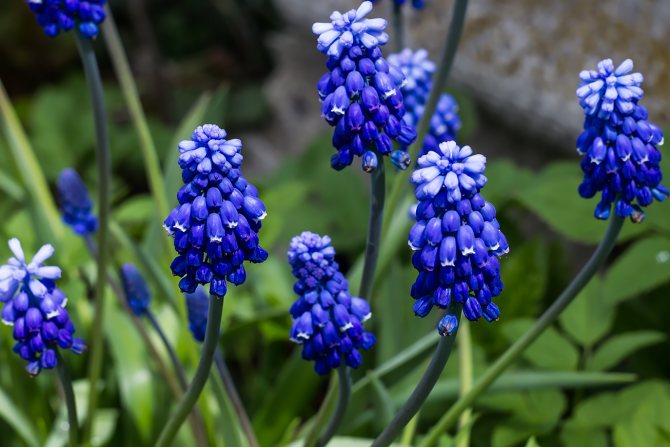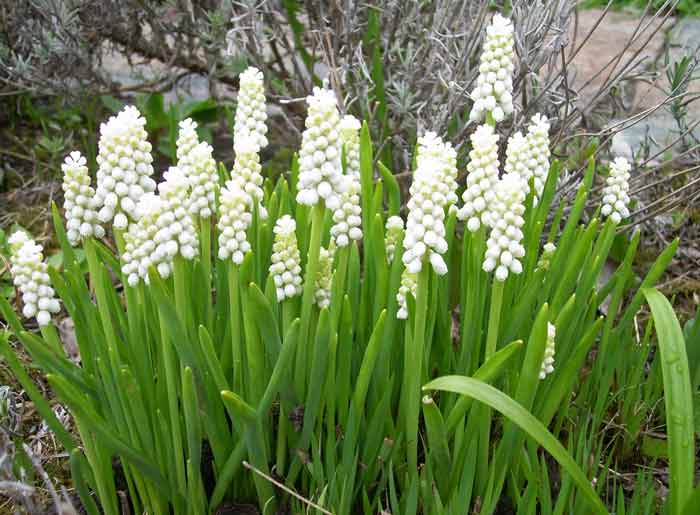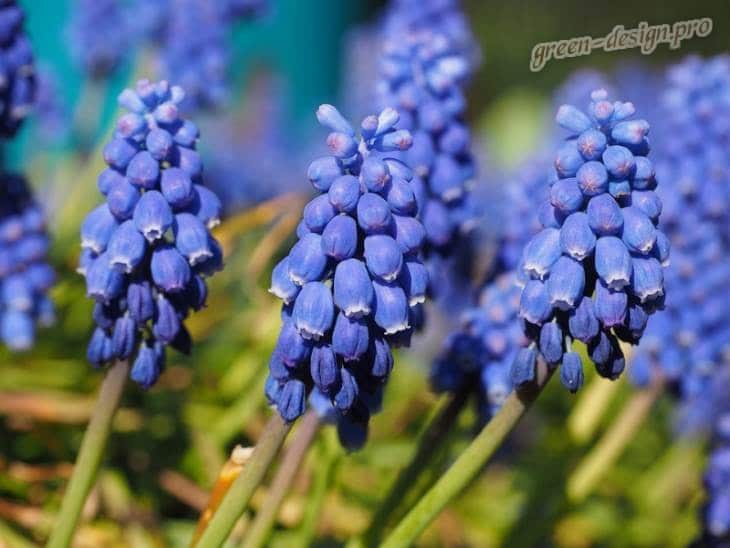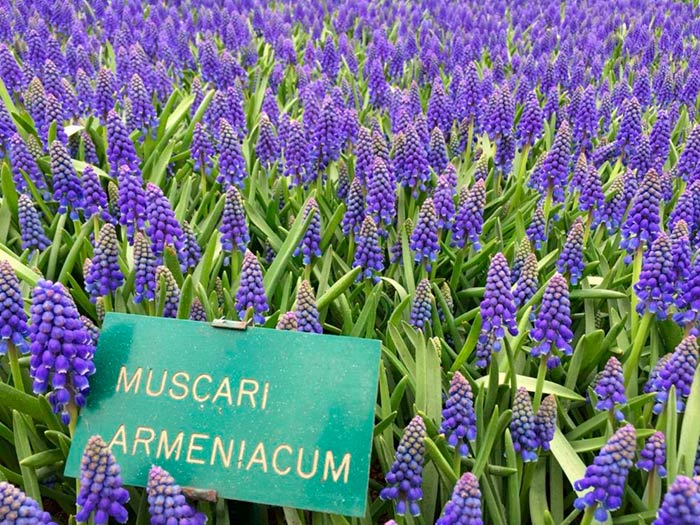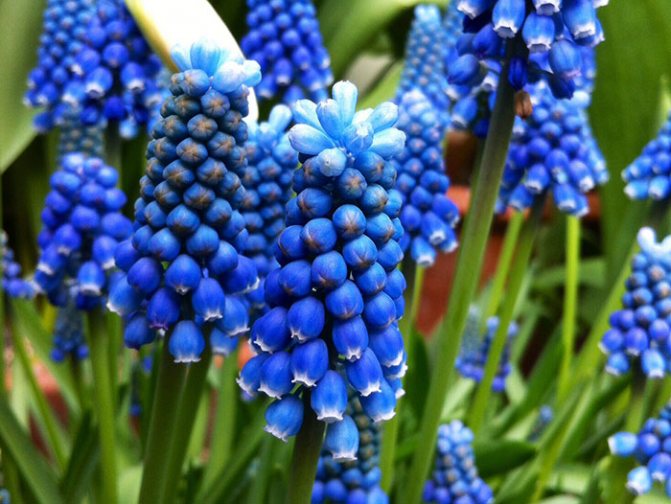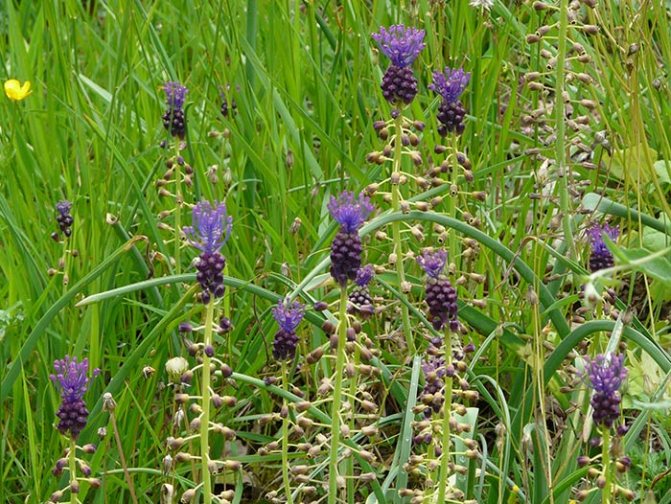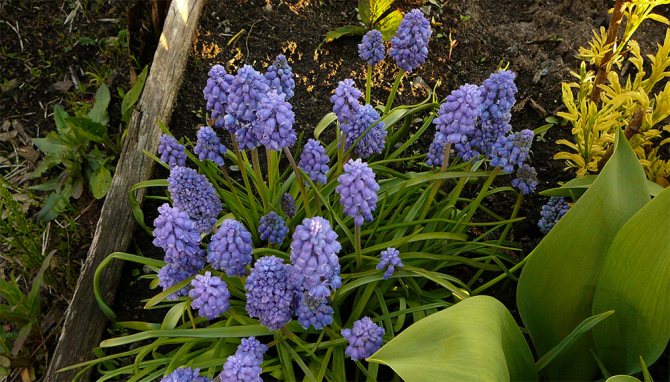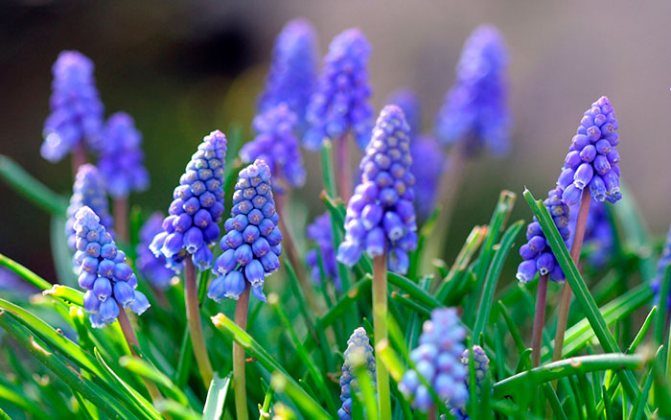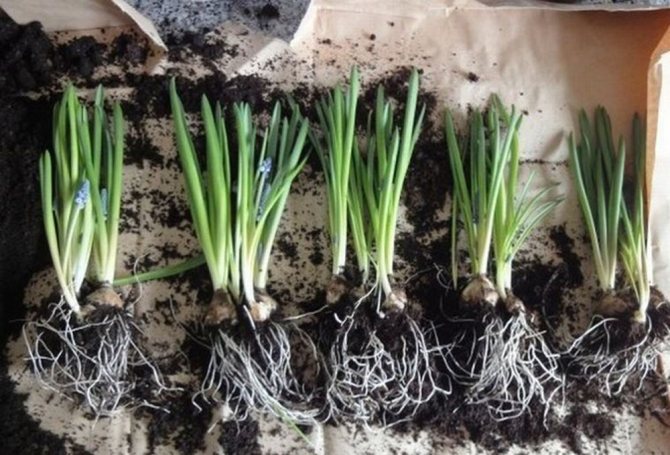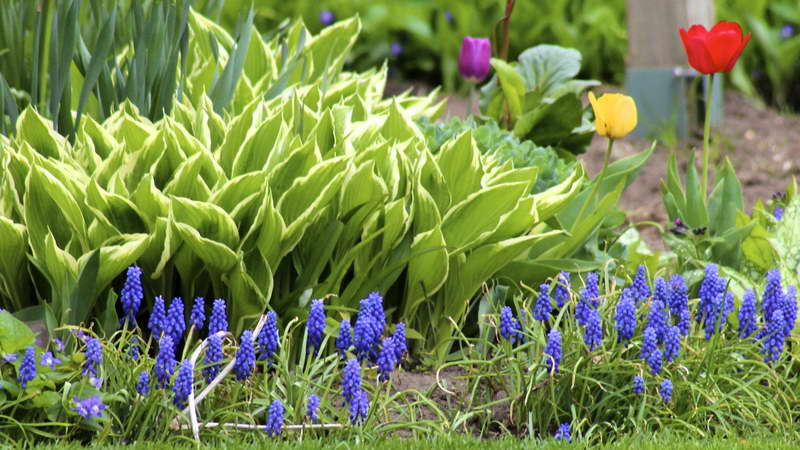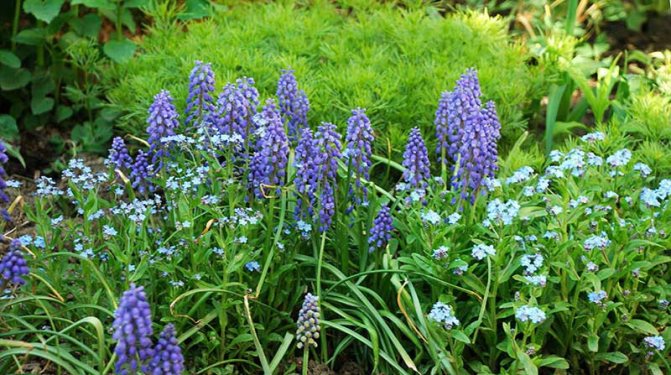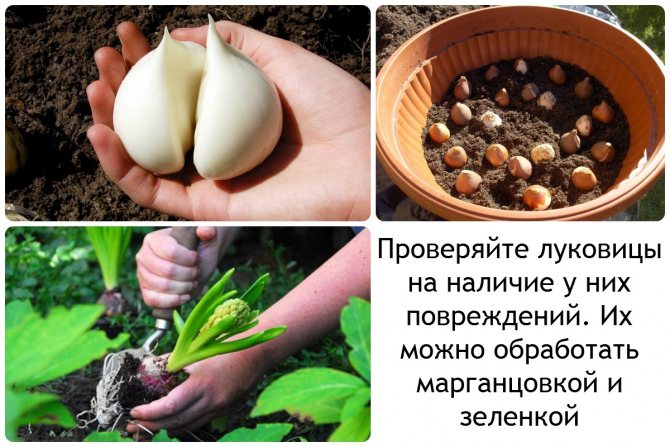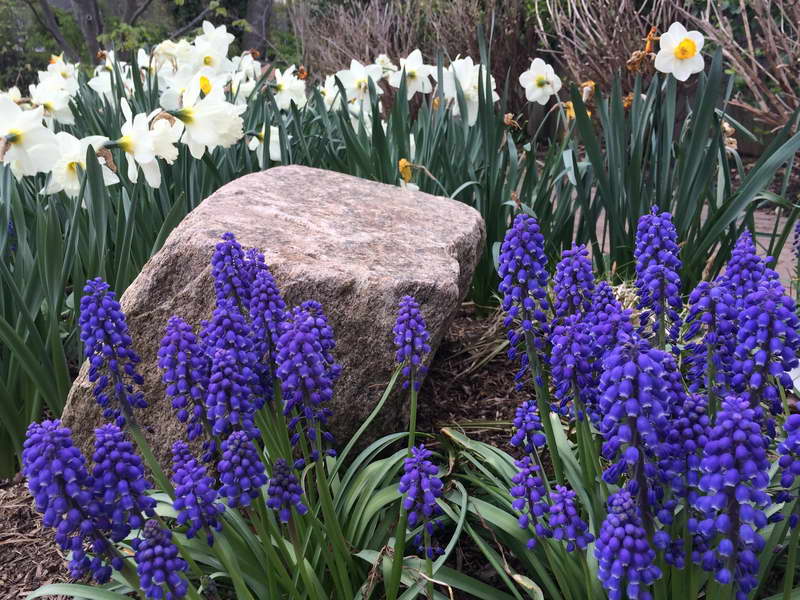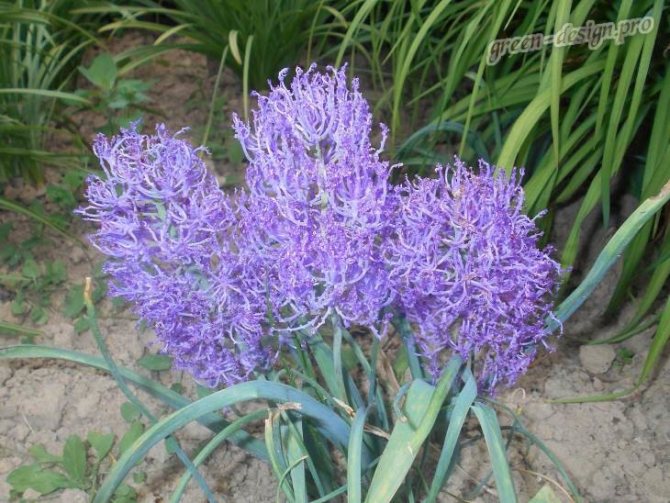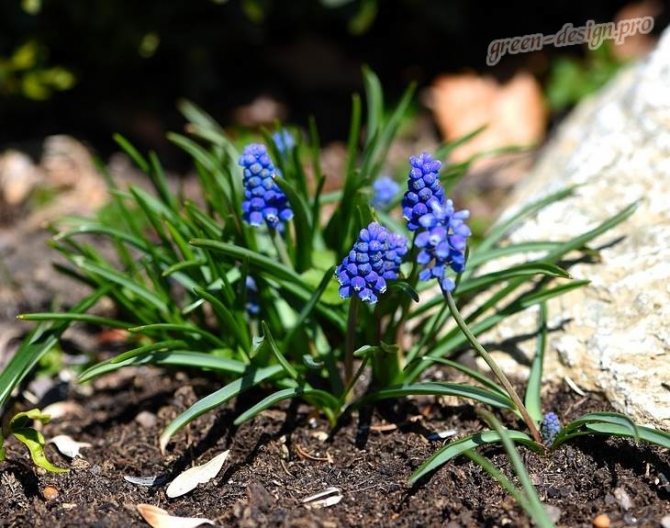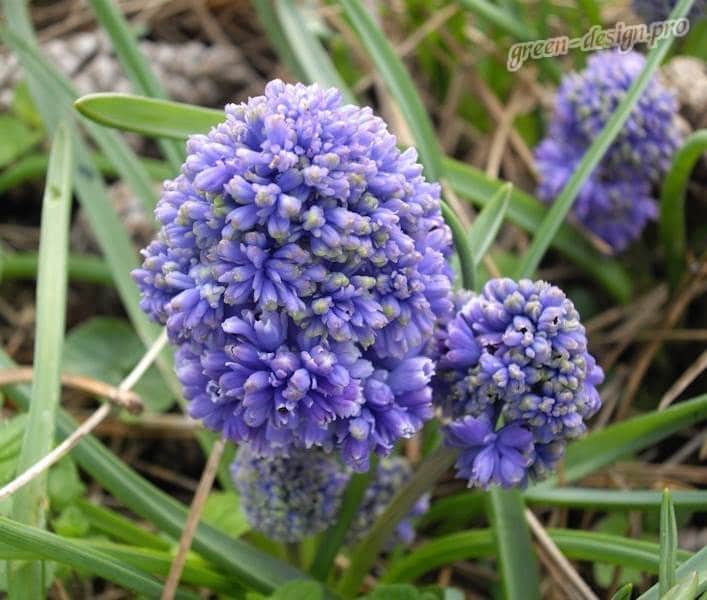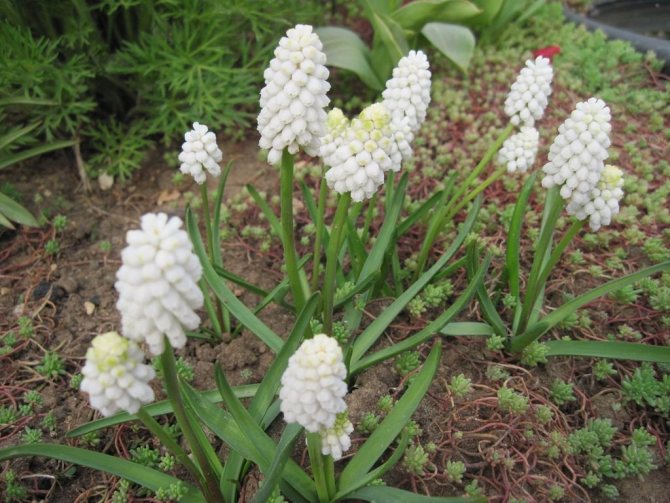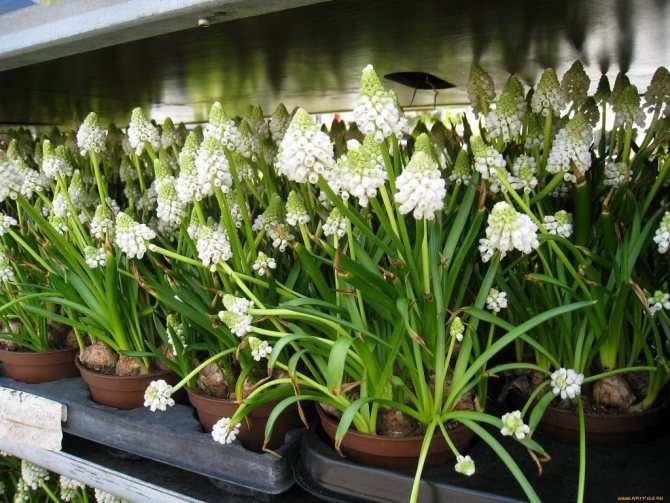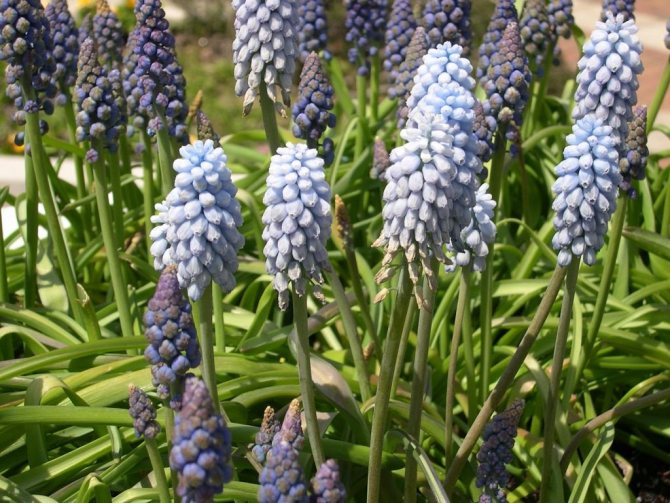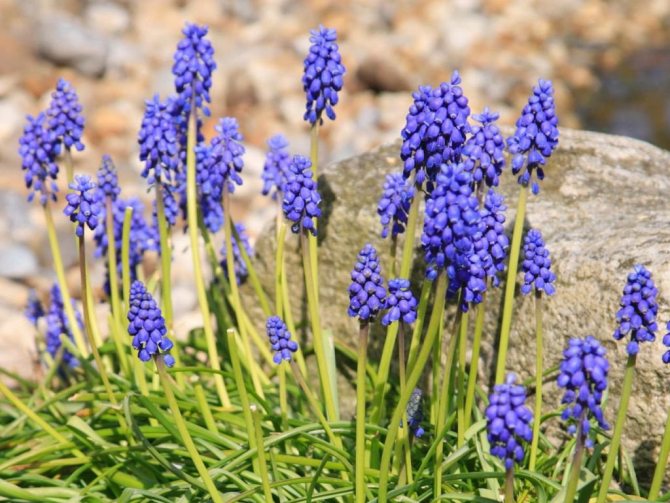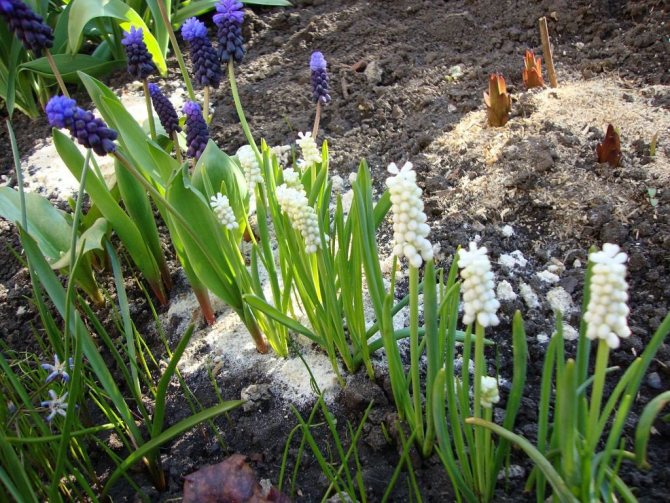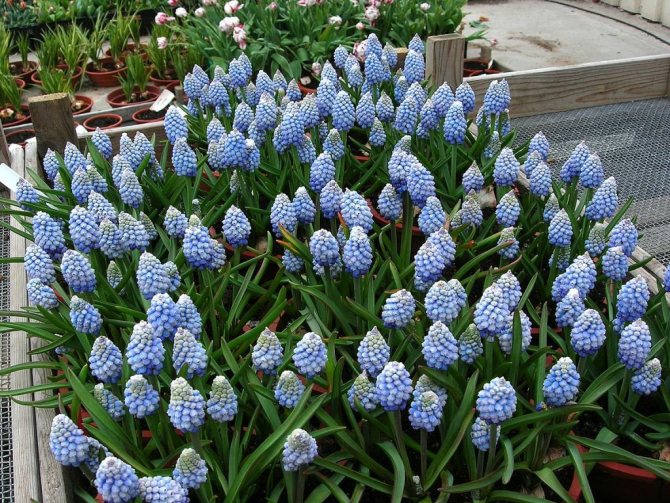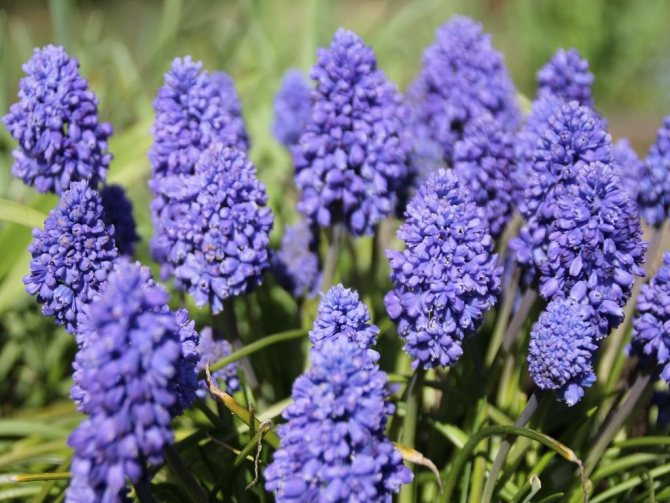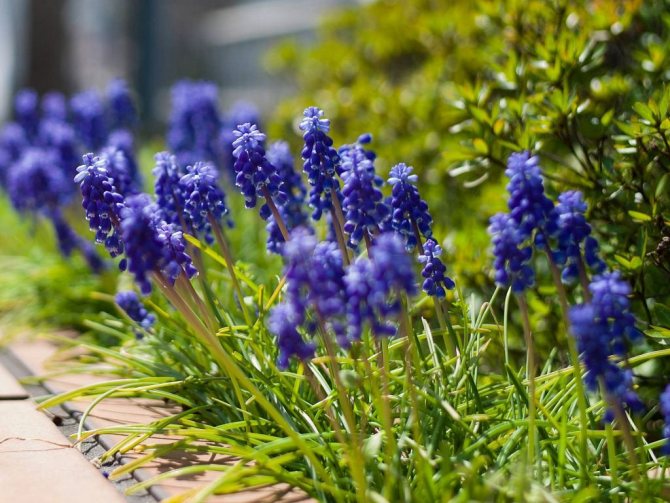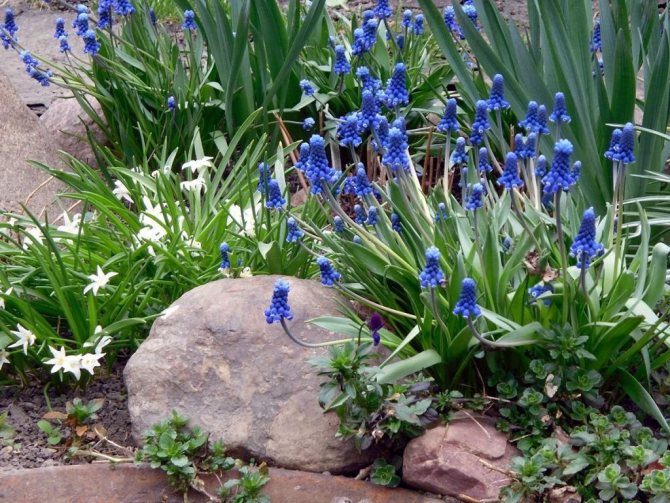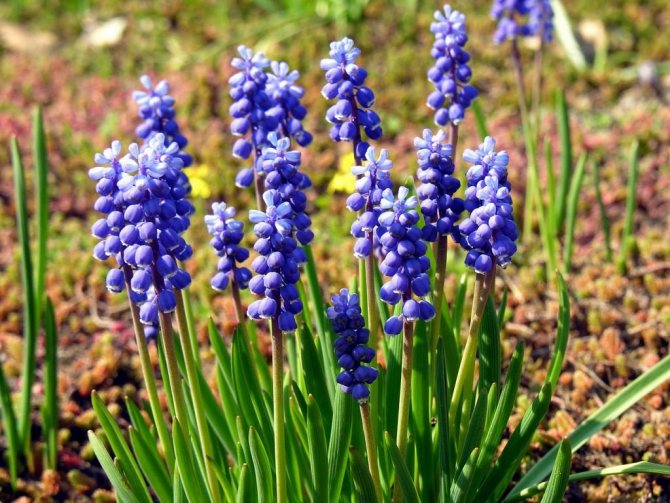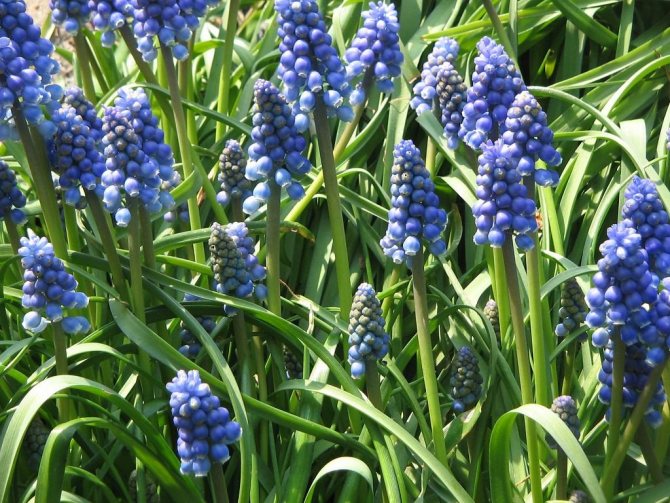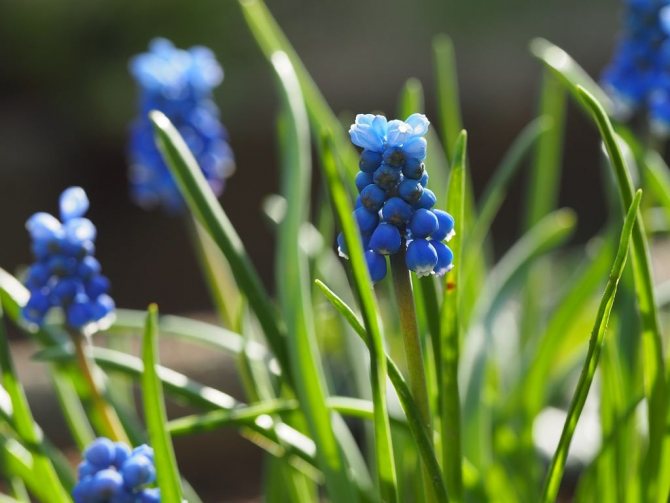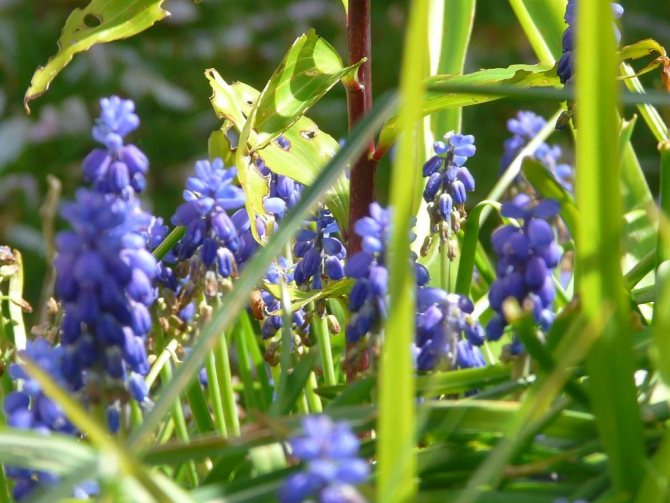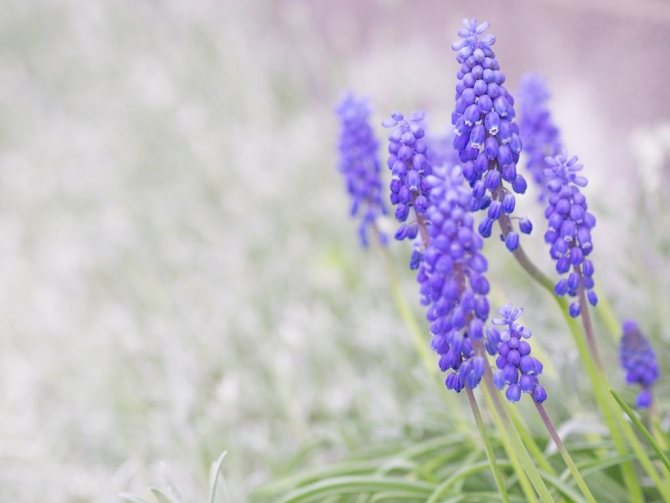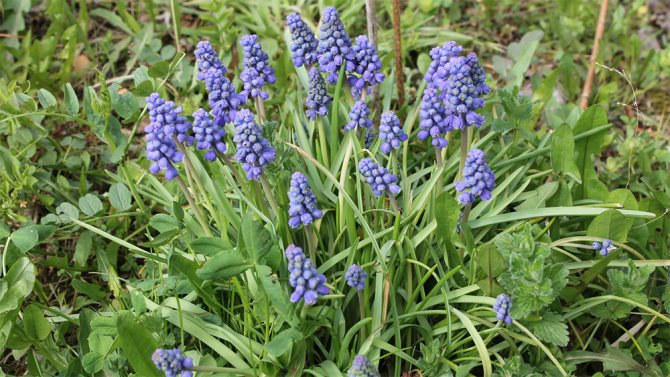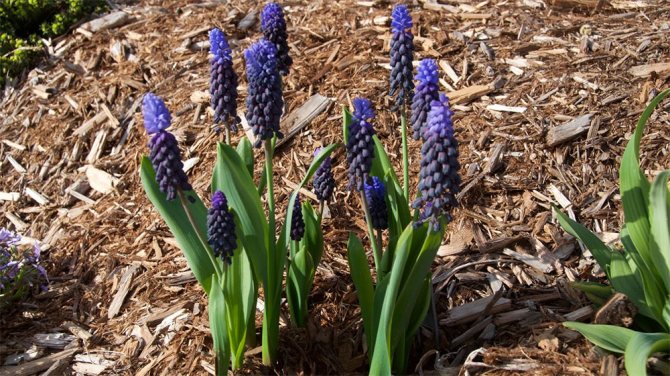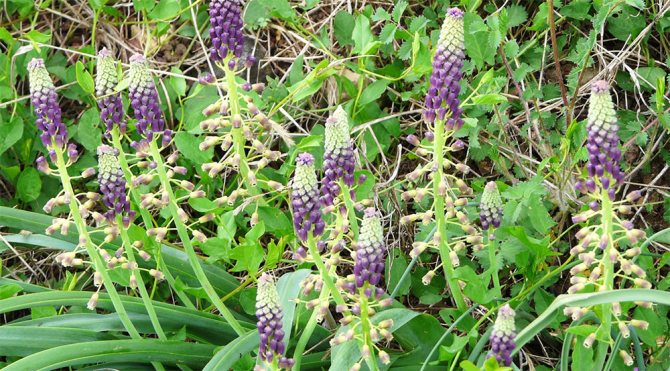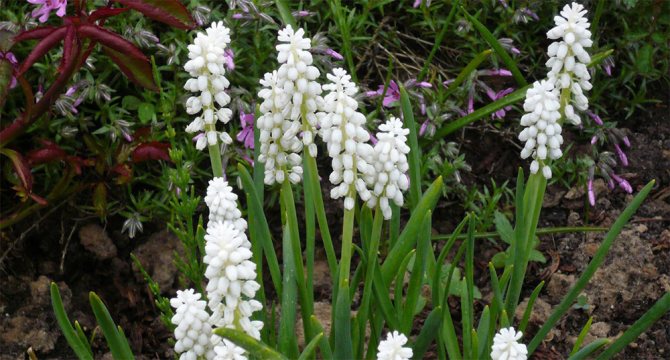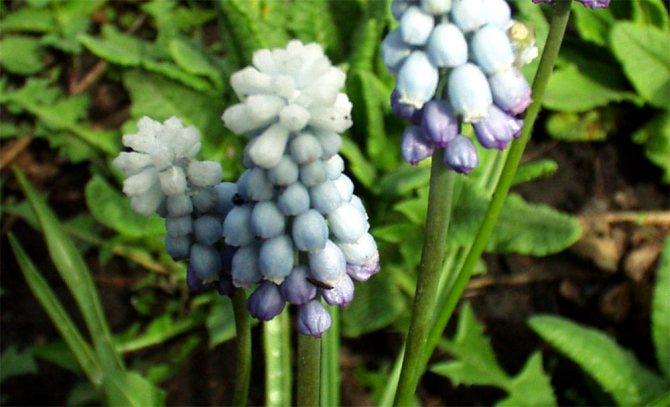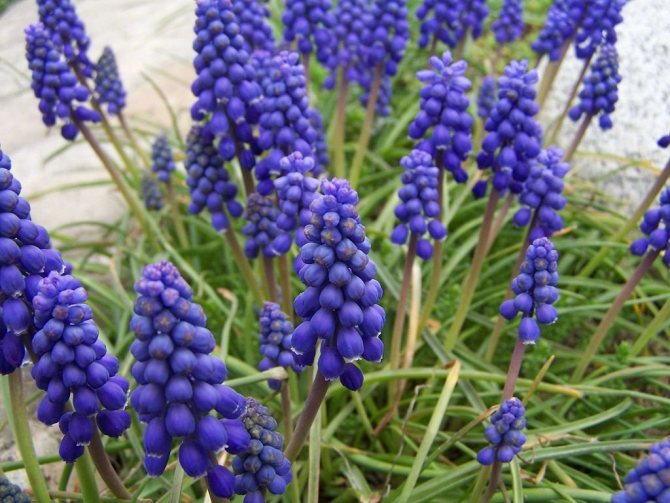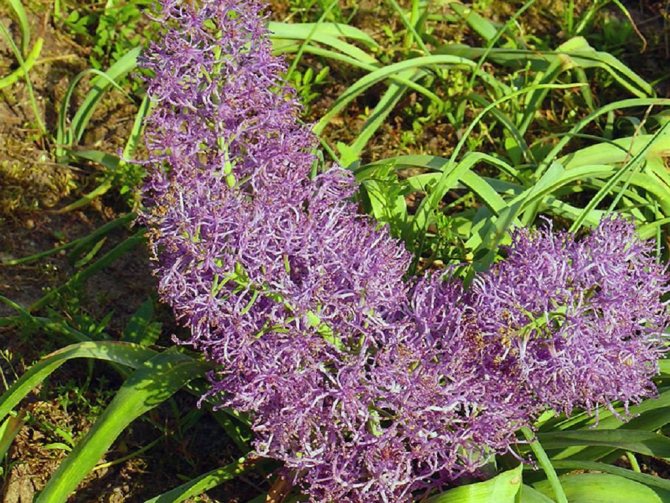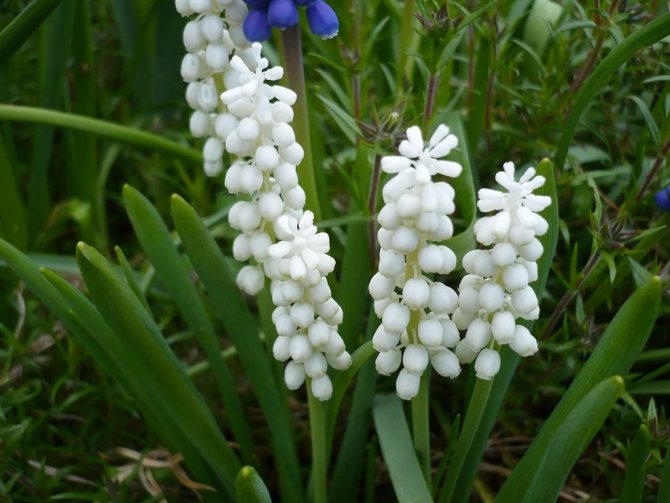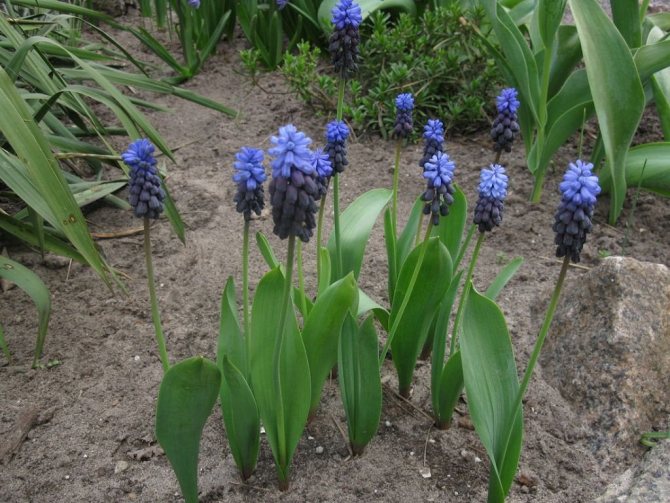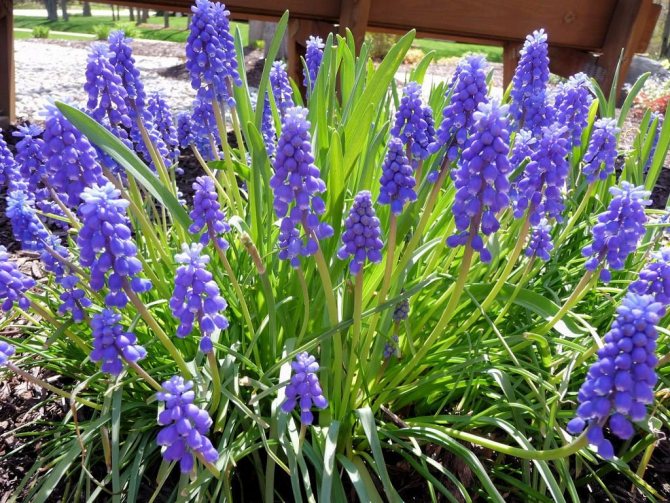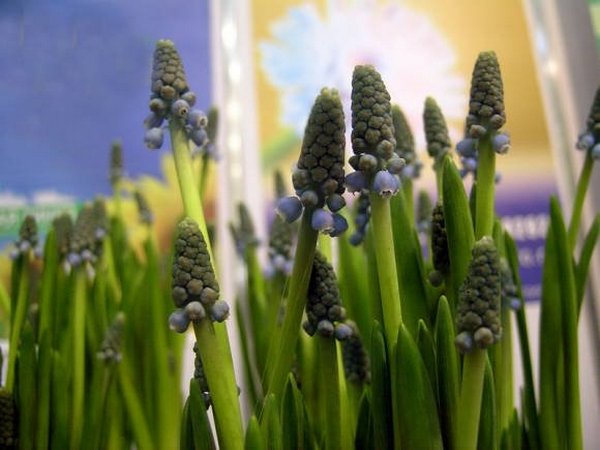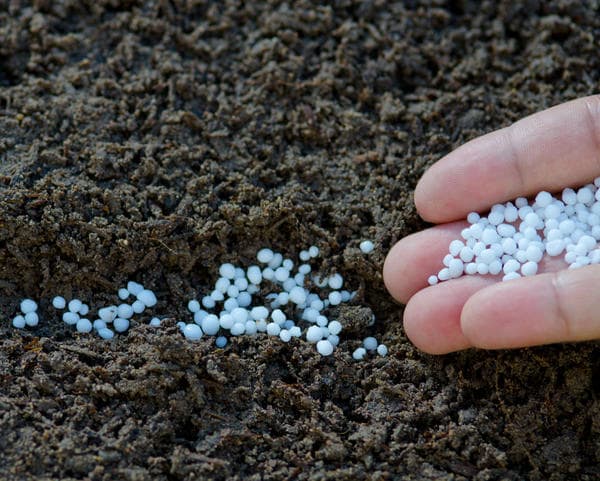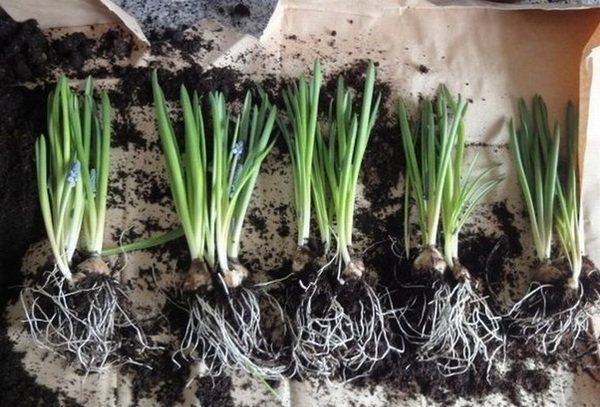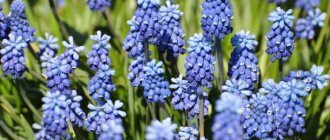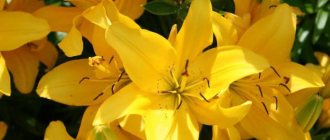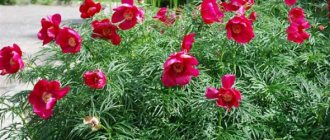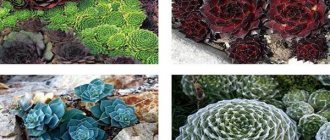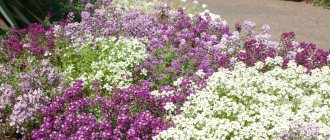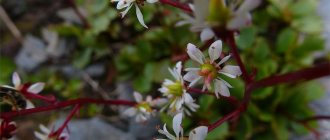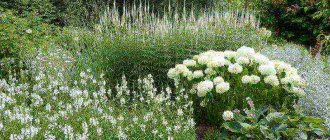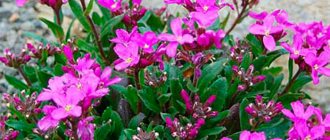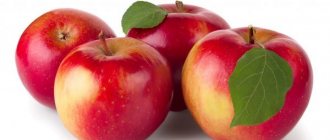Muscari is a bulbous perennial plant of the Asparageceae family. Muscari is also called mouse hyacinth or viper onion. The name muscari is often found - mouse hyacinth, its plant received for its small size and great similarity with hyacinth, its close relative.
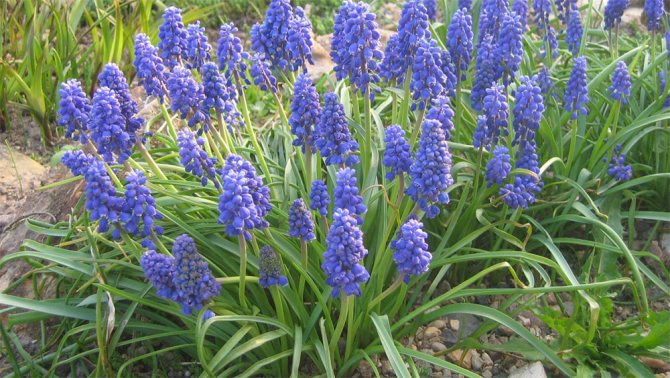
In its natural environment, it grows on forest glades and mountain slopes of the Caucasus, Asia Minor, the Mediterranean, Crimea, Central and Southern Europe. Muscari flowers are some of the first to appear in spring and are often grown for cutting. They usually reach a height of 40 cm. The flowers have an unusual cylinder shape with bent denticles, painted in white, blue or light blue. Possesses a pronounced pleasant aroma. It is an ephemeroid plant. Muscari grown in gardens are miniature and graceful. They are planted for decorative purposes to decorate lawns and borders, used in the preparation of rock gardens.
Features of the
The birthplace of the flower is Turkey. As already noted, the plant is small: the height is up to 40-60 cm, the basal leaves reach 10-17 cm. The diameter of the bulb can reach 2 cm, the length is 1.5-3.5 cm. The outer scales are light-colored.
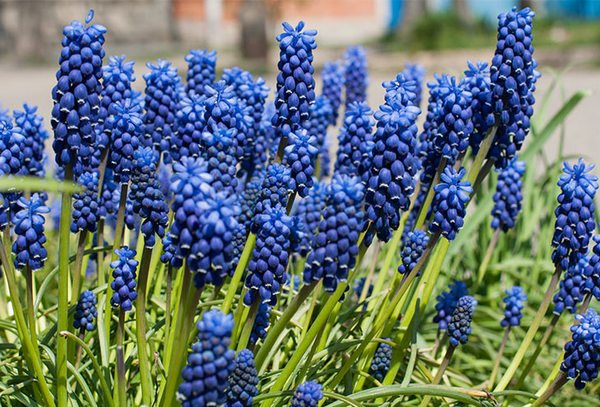

Muscari is a short plant
Flowers with perianths of various shapes - from barrel to cylindrical, are densely placed on the leafless peduncle. 6 fused petals give a special charm to the flower. The muscari fruit looks like a ball slightly narrowed downwards. It is divided into three nests with black shriveled seeds.
Muscari are perennial ephemeroids. This means that after flowering, the ground parts die, and the bulb "falls asleep", storing a supply of nutrients.
On a note! The plant attracts gardeners with its decorativeness and unpretentiousness.
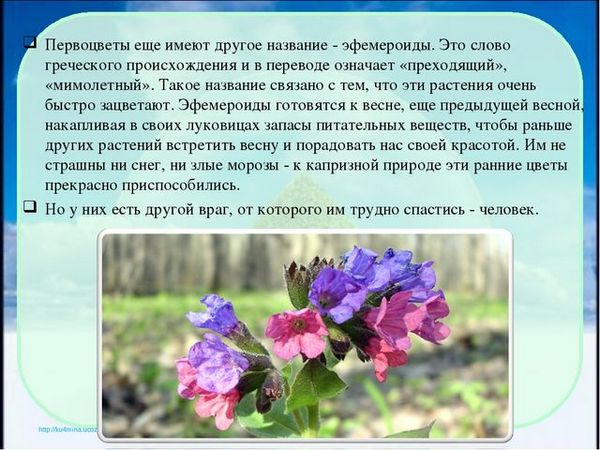

Muscari - ephemeroids
Popular varieties
Phlox flowers: varieties, what they look like, types
In the genus of mouse hyacinth, experts have about 44 varieties. Most of them are endowed with a naturally chic appearance, which allows landscape designers to use them when landscaping a site. Below you can find the most popular muscari varieties.
- Armenian muscari (muscari Armeniacum) is a fairly common variety among flower growers, which is distinguished by the formation of large multi-flowered inflorescences. Each inflorescence contains 48-50 buds. You can admire the blossoming flowers from mid-May to late spring. Flowers of the Armenicum variety are painted in a bright blue palette. In the area of the outer parts of the petals, a white border is formed. During the flowering period, an amazingly pronounced aroma emanates from the culture. The Armenian variety contains several varieties of flowers. The most spectacular are Alba, Sapphire and Blue Spike.
- Plumosum (Muscari Plumosum) is an ornamental culture, the height of which reaches 18-20 cm. The flowering of the variety is quite lush. The length of the spikelets is within 7-8 cm. On one side of the flowers there are large pedicels, which form a crest on the inflorescence. Each bud is colored in a blue-violet palette. The buds begin to bloom towards the end of spring. The spikelet arrows grow, and by the end of flowering, their length can reach 70 cm.
- The penny-shaped muscari is a bulbous plant, the height of which reaches 14-15 cm.Dense spike-shaped inflorescences are formed in the area of the tips of the arrows. The buds of the variety are rather small. They are painted in white or pink shades and are tightly pressed against each other. Album (with white flowers), Рink Sunrise (Pink Sunrise, soft pink double flowers), Surprise became the best types of bunch-shaped flowers.
- Broadleaf muscari is a variety that is distinguished by the formation of wide leaf plates, which in appearance resemble the outlines of tulip foliage. On each plant, several peduncles appear with the presence of dark blue, small-sized, barrel-shaped buds. This muscari, planting and caring for which is not difficult, can become a real decoration of the flower bed.
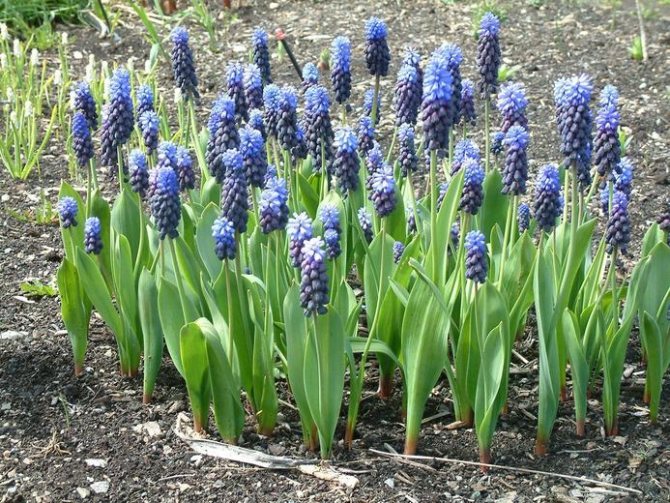

Broadleaf variety
Such varieties as look quite impressive on a flower bed:
- muscari Azureum;
- Muscari Valerie Finnis;
- muscari Latifolium.
What you need to know about Muscari?
Planting is carried out in the fall, until the end of October.
Even before the leaves appear on the trees, the first inflorescences appear in early spring.
On a note! Muscari grows well in sun or partial shade.
Almost any soil is suitable, but with a good permeable layer. Therefore, viper onions do not like clay and peat.
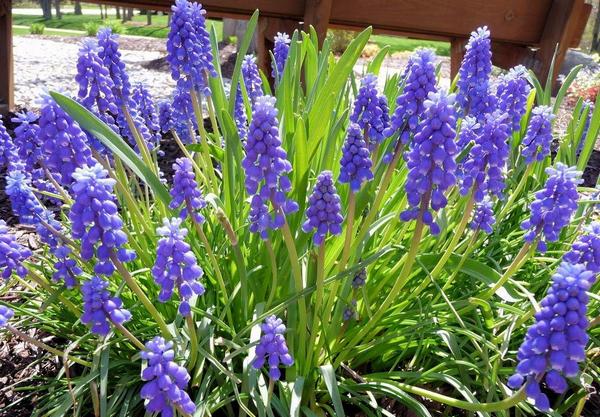

Muscari grows well in the sun
The growing season coincides with the period of spring showers, due to which the plant has to be watered only in the case of a winter with little snow and a dry spring. During the dormant period, the plant is not irrigated with water.
On a note! In autumn, you can apply organic fertilizers while digging: 5 kg of bait is consumed per square meter.
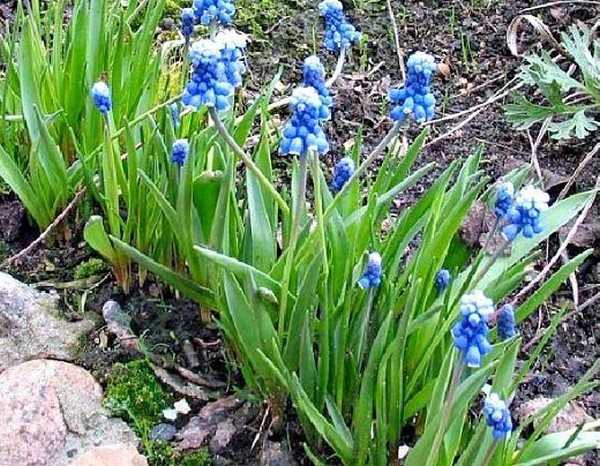

They feed the plant in autumn
Reproduction occurs by self-seeding or vegetatively by daughter bulbs.
Pests: slugs, spider mites, voles.
Diseases: green cucumber mosaic.
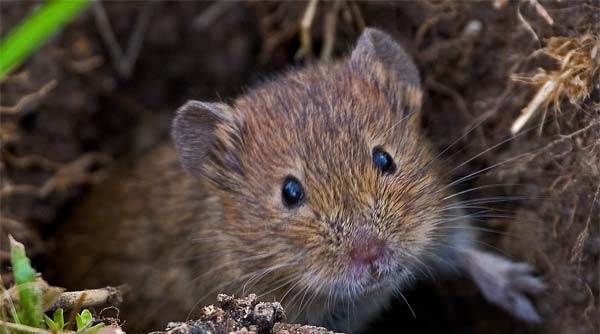

The plant can suffer from voles
Care secrets
Landing. It is best to replant plants at the end of flowering and growing season (August-October). They are distributed in groups of up to 10-15 pieces, but there should be free space between the individual bulbs. This will make the flower garden more decorative and noticeable. Before planting, the bulbs are inspected for damage, rotten and dark areas are cut off and disinfected. First, they are etched in a solution of "Karbofos", and then dipped in a strong solution of manganese for an hour.
The landing site should be sunny or in partial shade. The soil is pre-dug up and large clods are broken. The landing pits at a distance of 6-8 cm are made shallow (up to 8 cm). Small onions are planted in a shady place in rows in holes. First, sand is poured into the hole on top of the ground, and then the planting material is laid out strictly vertically. The bulbs are sprinkled with soil, tamped and watered well.
There is no need to dig up the muscari every year. Plants overwinter well in temperate climates, but every 4-5 years, the planting is too thick. They need thinning and renewal of the topsoil.
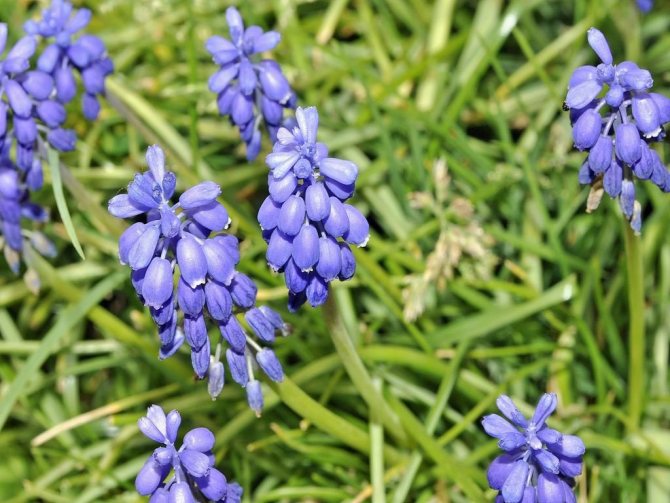

Care. Regular maintenance of outdoor muscari includes watering. The soil should always be slightly moist, but without stagnant water, otherwise the bulbs will rot. In the absence of precipitation, irrigation is carried out in the morning.
In early spring, plants are fertilized with compost or humus. The first feeding is carried out when sprouts appear. Re-fertilization is planned for the budding period. While the muscari is blooming, it is enough to occasionally weed the soil near the flower garden.
Ripe seeds are very easily poured onto the ground, contributing to abundant self-sowing. To prevent it, after the buds wither, the inflorescences are cut off.
The flowers have good immunity, but the bulbs can suffer from fungal diseases. This occurs in thickened plantings, on heavy and marshy soils, as well as in contact with a diseased plant. Of the parasites, mouse hyacinth overpowers aphids.She not only drinks the juices of the plant, but also carries viral infections. It is almost impossible to save the affected specimens. You need to dig them up to prevent the spread of the infection.
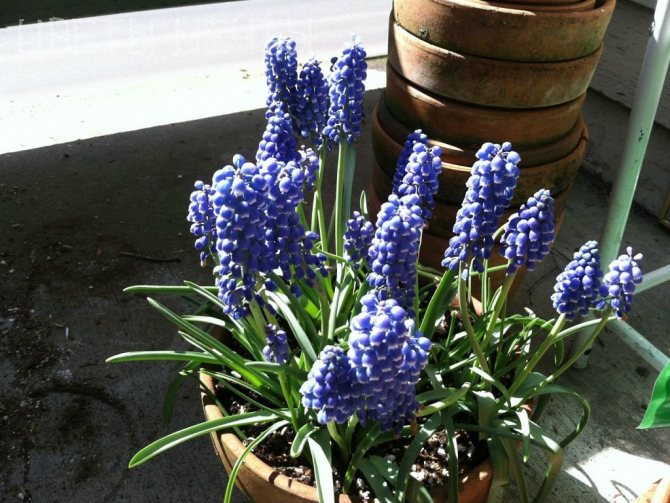

Wintering. Muscari has pronounced periods of activity and rest. Already at the beginning of summer, the inflorescences dry out completely, but the leaves persist until frost. Cutting them ahead of time is not recommended, since at this time there is a supply of nutrients in the bulbs. In winter, during the dormant period, the need for watering disappears. Dry shoots are cut off, and the surface of the soil is mulched with peat and sprinkled with dry foliage.
Flower in the garden
Seated in small or large groups, muscari look great in spring against the backdrop of bare branches of shrubs. The blue-blue scale is combined with spring flowers: bright red tulips, sunny daffodils. Muscari look beautiful and festive against the background of yellow forsythia in bloom.
Muscari looks picturesque against the background of blue forget-me-nots and snow-white tulips. The plant can be planted in a small container and supplemented with a blue-blue "spot" flower bed composition, frame a pond. It must be remembered that among tall flowers such as gladiolus, salvia muscari "will be lost".
On a note! It is necessary to plant a perennial in the foreground with the expectation that it can grow.
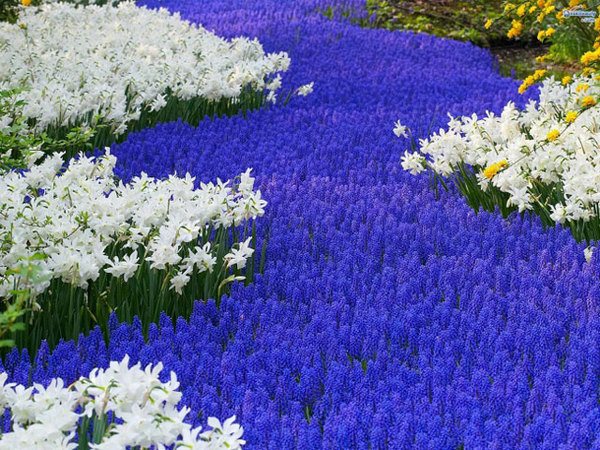

Muscari looks great in combination with many other colors
You can plant muscari in the form of mini-flower beds, decorating their growth with a tree, for example, a fence made of birch branches. The white color of the bark looks very festive against the background of blue-blue inflorescences.
It has already been said about the contrasting combination of white-blue-blue mass of muscari with bright colors of yellow, orange. You can achieve smooth overflows of color by planting different varieties of mouse hyacinth on the same flower bed.
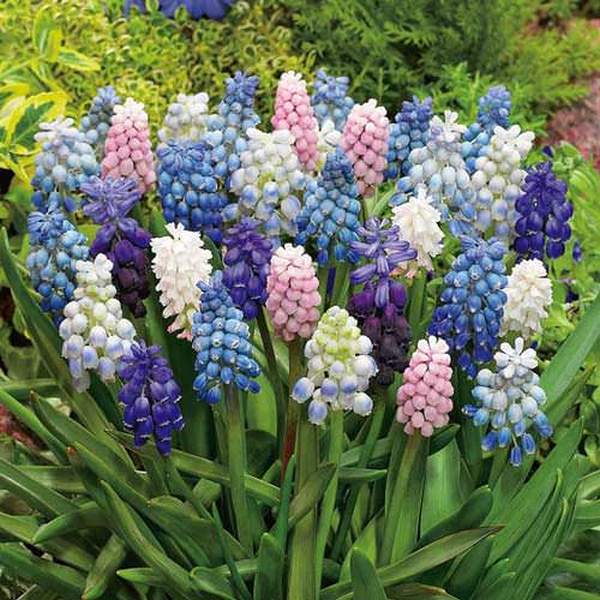

You can plant different varieties of this flower on the same flower bed.
Some find it a good idea to plant a muscari under a tree. The foliage appears after the flowering of the plant, so that sunlight is provided for growth.
To grow a flower on alpine hills, in rockeries is both beautiful and reasonable in terms of comfortable conditions for the plant. Delicate bluish-white and even pink shades are beautifully combined with the texture of stone, water.
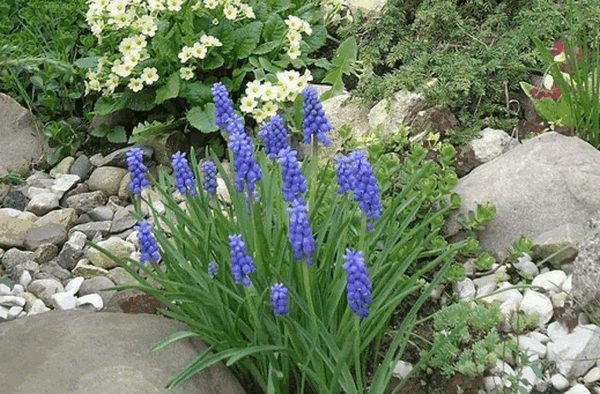

Muscari is grown on alpine hills
Depending on the variety, muscari can do without transplanting for several years in a row. They bloom in early spring when other plants are adorned with bare branches only. This allows muscari to be planted next to perennial shrubs. The flowers will get enough sunlight and the shrub will look beautiful all spring.
On a note! Muscari grow poorly on waterlogged soils. Breeders advise planting the plant on elevations, protected from strong gusts of wind.
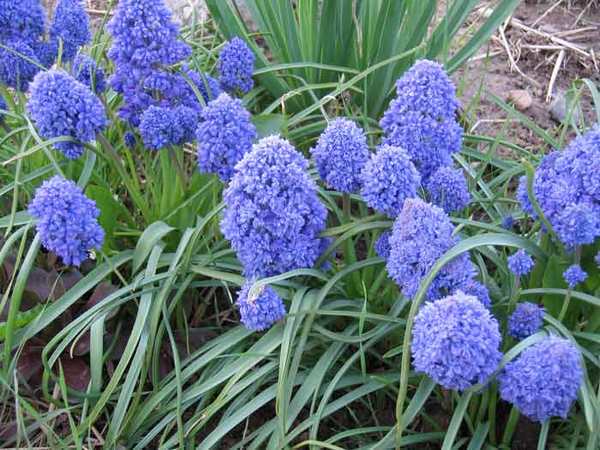

It is worth planting a flower in a place protected from strong gusts of wind.
There are cultivated varieties for growing at home.
Description of the plant
Muscari is a small-bulbous perennial 10-40 cm high. The underground part of its stem is an oblong bulb 3.5-5 cm long and 2-4 cm in diameter. The bulb is ovoid and covered with thin white scales. A bunch of thin roots grows on its bottom.
In early spring, the plant forms a rosette of linear dark green leaves 17-20 cm long. Each bulb grows 2-6 leaves. They have a narrow linear or oval shape with a solid edge and a pointed end. There is no drawing on the surface of the sheet.
The flowering period, depending on the variety and weather conditions, starts from late March to early June. It lasts 1-2 weeks. Initially, a fleshy, erect peduncle grows from the center of the leaf rosette. It has a cylindrical shape and is light green in color. Closer to the flowers, the stem acquires a mauve shade.
The racemose inflorescence consists of many small flowers located close to each other.Its length is 7-8 cm. A single flower with a spliced corolla resembles a lily of the valley in structure. The edges of the petals of the barrel-like flowers are strongly curved and divided into 6 lobes. The color is white, lilac, blue, blue or purple. Sometimes there is a contrasting border along the edge. During the flowering period, most varieties exude an intense musky aroma.
The inflorescence begins to bloom from the lower flowers. Above are sterile buds designed to attract insects. Bees and butterflies get nectar from the tube with their proboscis and pollinate the ovary. After pollination, the fruit is formed in the form of a spherical or heart-shaped seed capsule with fleshy walls. Inside are small dark brown seeds.
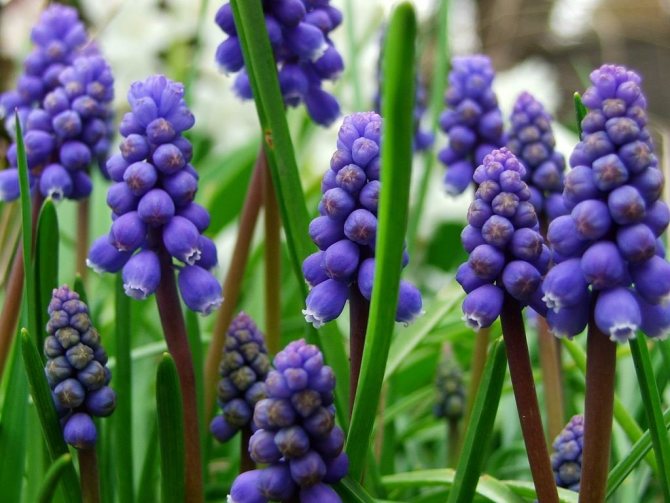

Types and varieties of muscari
Indeed, most muscari bloom in early spring - in April. But there are also late-flowering varieties that bloom in the second half of May - early June.
Muscari Armenian is a popular winter-hardy variety with a pleasant smell. The top of the inflorescence is colored in a lighter shade of blue.
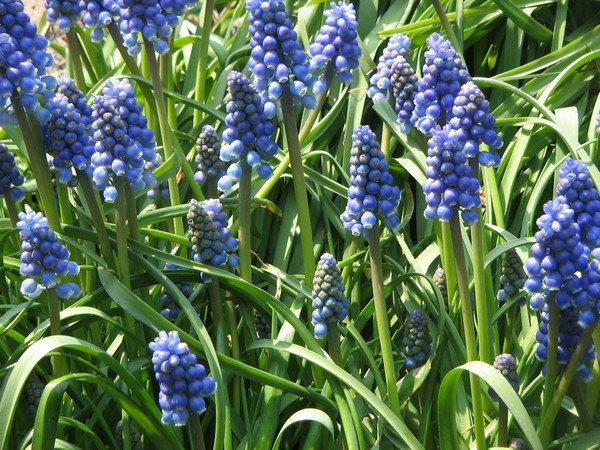

Muscari Armenian
Blue Spike differs in that the inflorescence contains up to 170 flowers. Therefore, it is also called terry.
Two more popular varieties of this species are Heavenly Blue, which translates to sky blue, and Cantab, a Cambridge, low-growing and late-flowering variety.
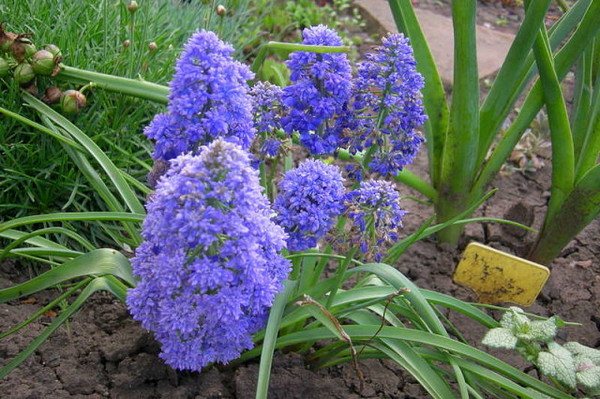

Heavenly Blue variety
Recognized by gardeners and broad-leaved muscari, having a height of up to 25 cm. The inflorescence has about 100 flowers of dark and light purple color.
On a note! The characteristic shape of the leaves is lanceolate.
Muscari azure grows naturally on dry mountain slopes in Turkey. It has several names: azure muscari, azure hyacinth. It pleases the eye with bell-shaped flowers of a light blue color.
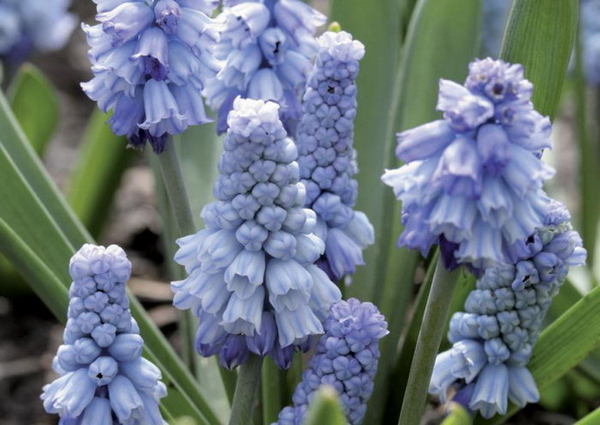

Muscari azure
White muscari are very fond of gardeners for their decorative effect. For example, grade Alba.
Muscari Oche with a two-color inflorescence became the basis for the unusually beautiful Magic white and blue varieties.
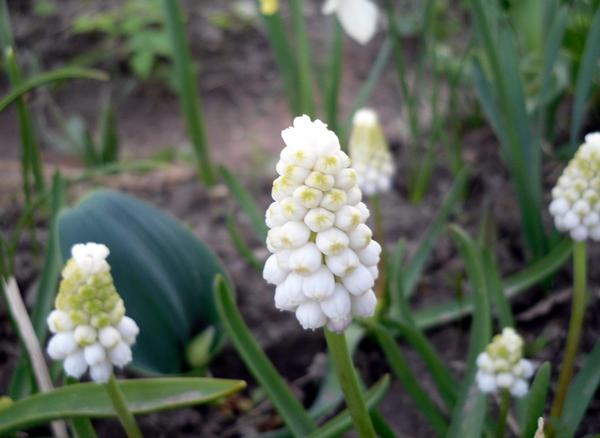

Muscari Osh
Muscari Fantasy Creation looks unusual due to terry inflorescences that change color from greenish to dark blue.
On a note! For this property, they are also called muscari chameleons.
Muscari pretty naturally grows in some parts of Israel. Differs in tiny growth and white color of bending teeth. The plant blooms in winter.
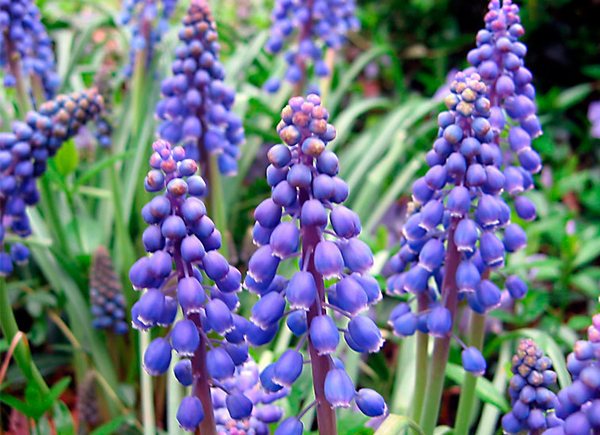

Muscari is pretty
Muscari pale in Russia is grown less often than other varieties. The flower differs in that it is not pulled together along the edge, has a bell-shaped perianth. A variety with pinkish flowers attracts attention.
Muscari crested differs from its counterparts by the presence of a tuft at the end of the inflorescence.
On a note! Another feature is that during flowering it "grows" from 25 to 50-70 cm.
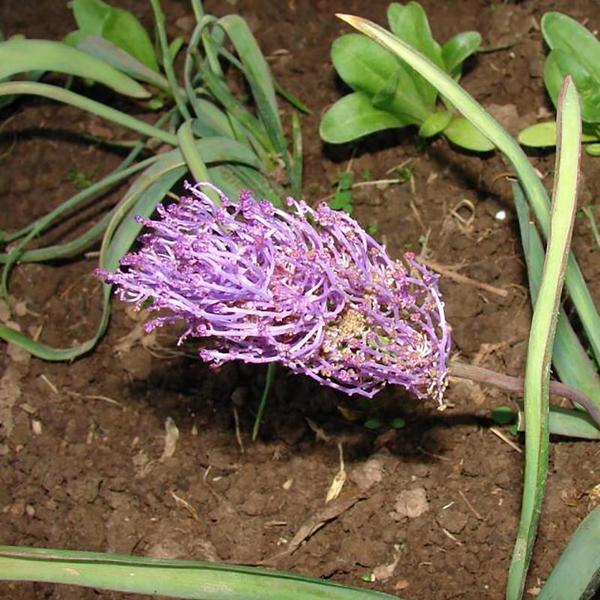

Muscari crested
The variety Plumozum is loved by flower growers. It is ideal for the climate of central Russia, tolerates winter well, does not require complex maintenance. Decorates the garden with shaggy blue-lilac flowers with an interesting aroma.
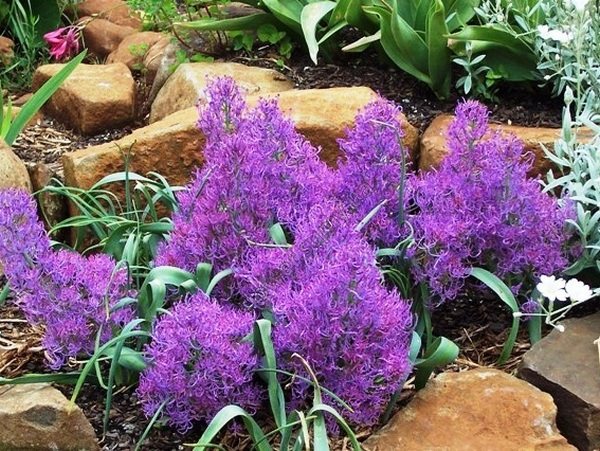

Plumozum variety
The above varieties are just a small part of the list of muscari species that growers bred.
On a note! For the sake of fairness, it should be said that the long-flowered, white-grass, large-fruited, strange, racemose and many other varieties enjoy the same share of success.
Description of the flower
There are a number of distinctive features that make it easy to recognize muscari among other colors. The culture bulbs are naturally endowed with oval outlines. Their length reaches 3 cm, and the diameter does not exceed 2 cm. The height of the mouse hyacinth is in the range of 28-30 cm. The sheet plates of the rectilinear type grow up to 12-15 cm. Each rosette contains 8-10 pcs. Peduncles are bare.
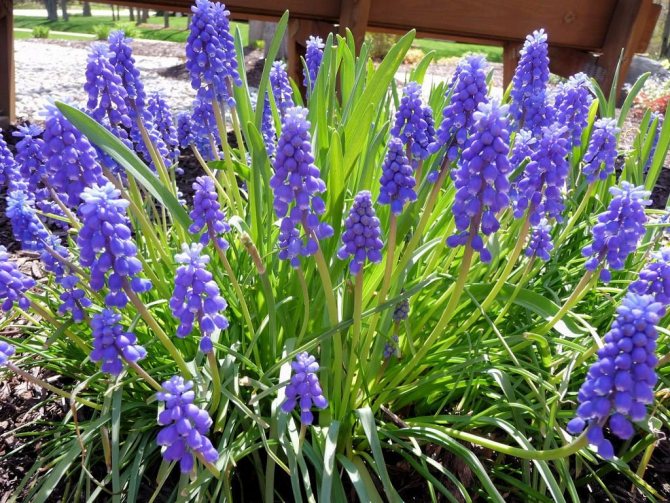

Mouse hyacinth fits into any design
For your information! The size of the cluster-like inflorescences does not exceed 75-80 mm. The flowers, formed from 6 petals with bent edges, are rather small, resembling bells in shape.
Inflorescences can be colored in different tones, namely:
- blue;
- azure;
- lilac;
- purple;
- pink;
- white;
- yellow.
Small bulbous perennial plantings are early flowering crops. You can admire the gorgeous flowering for only 10-14 days.
Among the main advantages of muscari are:
- good adaptation to a variety of habitats;
- increased endurance;
- easy care.
Choosing a place for planting and preparing the soil
The plant is not demanding for watering, but the soil should be loose and retain moisture well. Muscari grow poorly on clay soil. The composition of the earth is preferable to be slightly acidic. This will give the inflorescences a brighter color, and the bush will look more luxuriant.


Clay soil is not suitable for growing muscari
Flowers are planted in groups, so they look better. Before planting, it is advisable to dig up (or loosen) the soil by 8-10 cm.
On a note! For active development and flowering, fertilizing in the form of humus and compost is required.
Despite the short peduncle, muscari are not shaded by tall plants, because the mouse hyacinth blooms in early spring, when the rest of the flora is still asleep and there is no foliage on it.
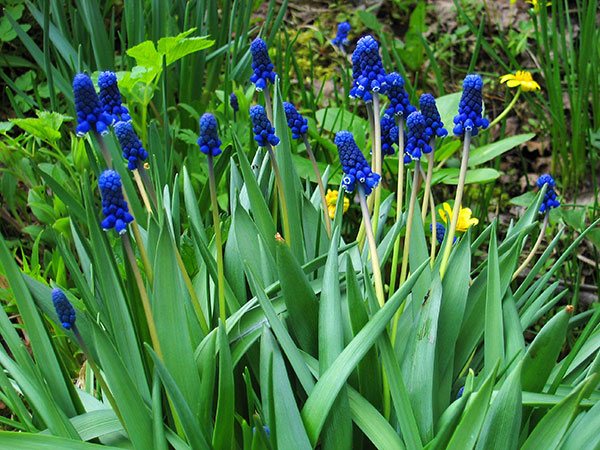

Muscari blooms in early spring
Muscari is a perennial representative of the plant world. With a sufficiently fertilized soil, it can not be replanted for decades. Therefore, if you place it next to other perennials, you can avoid unnecessary work.
Using muscari
Mouse hyacinth is cultivated mainly for decorative purposes. They are framed by flower beds, paths, and also planted in rock gardens and in front of shrubs. Intense inflorescence shades enrich the spring garden with pure blues, purples, pinks or whites.
Muscari looks good next to daffodils and tulips. They can also be combined with crocuses and spines. You should definitely plant a large group of plants with different shades of inflorescences and flowering periods. Some varieties are suitable for container growing on balconies and verandas. The aroma of flowering muscari repels harmful insects, so they are often planted among other crops as a natural insecticide.
Post Views: 3
What time to plant?
Experienced flower growers suggest planting muscari in the fall - from late August to October.
Muscari are sometimes grown in pots for spring holiday sales. After flowering, you can transplant it to a secluded place. By the fall, you can dig out the strengthened bulbs and use them for planting in the spring.
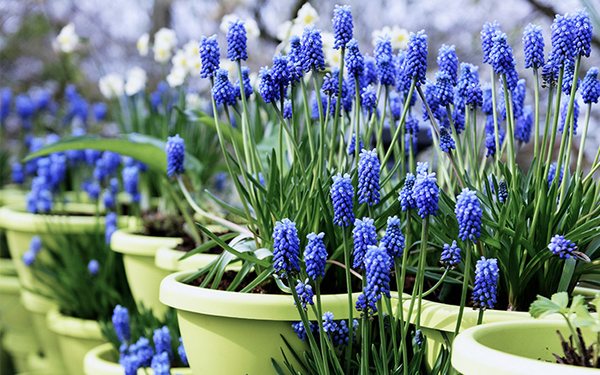

Muscari is also grown in pots
When purchasing material for planting in a store, you must carefully examine the shoots. They should show no signs of parasite infestation.
On a note! Sometimes in spring, nurseries offer flowering muscari seedlings. On the advice of the nursery staff, they can be immediately planted in the soil in a permanent place.
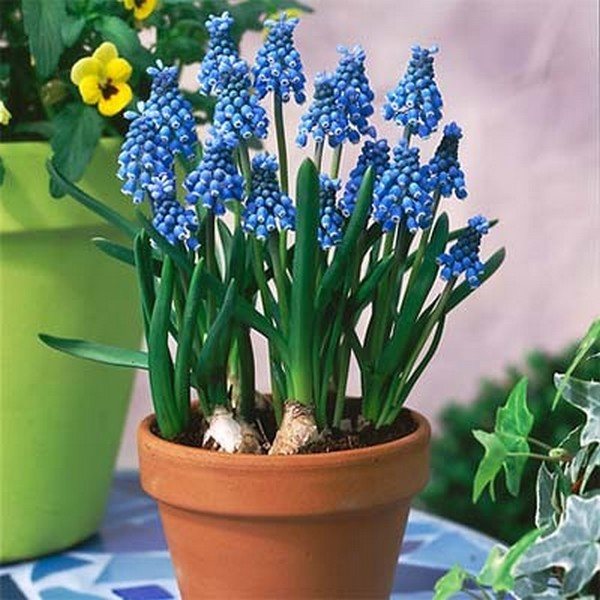

Blossoming Muscari Seedlings Available
Plant transplant
Strongly growing perennials can be divided and transplanted into new areas. Taking a shovel, you need to dig out a bush and carefully remove the bulbs, keeping a layer of soil on them. It should be borne in mind that the root system of the flower is fragile, so you should not shake off the bulbs. After transplanting, it is necessary to moisten the soil abundantly.
When to transplant muscari? Transplant work is best carried out in October, when the period of active growth is over.
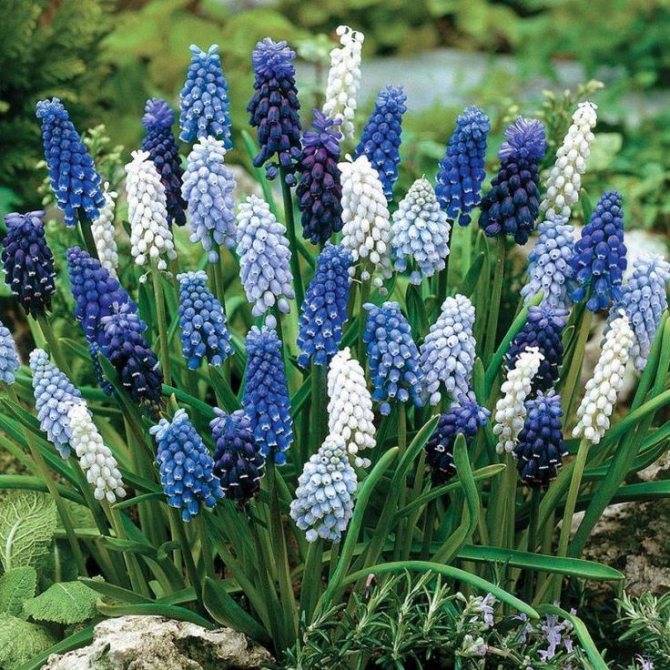

Muscari is an amazing culture that is often used when decorating a site
Disembarkation rules
Before planting, it is necessary to sort out the bulbs, removing the diseased and damaged ones, treat them before planting with a strong solution of potassium permanganate or with Fitosporin.


"Fitosporin"
A layer of sand up to 2 cm can be added to the soil under the bulbs. It will serve as drainage for liquid and protection from pests.
It is better to plant the plant in groups, but the distance between the bulbs should be at least 4-7 cm. The depth of planting the bulbs is 6 cm. When planting, the soil should warm up to eighteen degrees Celsius.
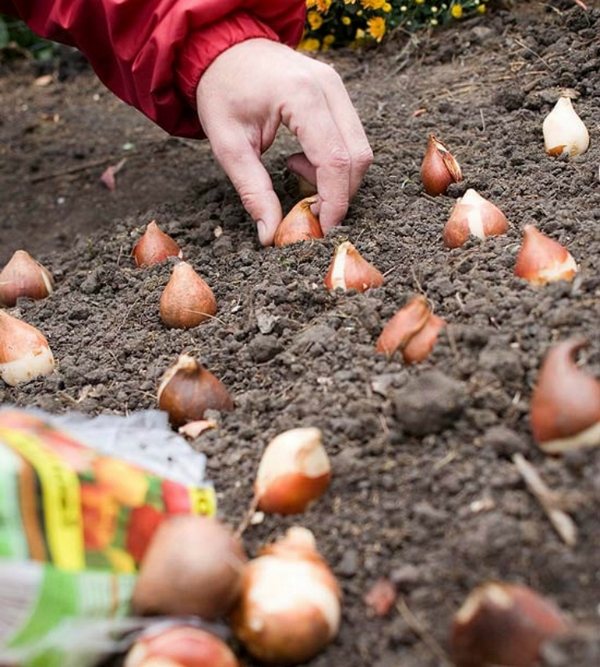

The distance between the bulbs must be at least 4 cm
On a note! If sowing is done with seeds, they are placed in the soil to a depth of 2 cm. Flowering in this case will begin only in the third year after planting.
Muscari: planting and grooming outdoors
Euphorbia flower - types and popular varieties
To plant Muscari flowers, as they are also called, you need to purchase the seeds or bulbs of the plant. For beginners in the field of floriculture, experts recommend giving preference to the second option.
Note! Before sowing planting material, it is important to soak the seeds / bulbs in a solution of potassium permanganate for the purpose of disinfection.
Planting operations should be planned for the last days of August.
When choosing a site for planting, it is necessary to give preference to areas well-lit by the sun's rays with the presence of loamy soil. Areas located on slopes should be avoided.
Step-by-step planting process:
- The soil in the zone selected for planting is dug up.
- A small part of compost, humus and ash must be added to the soil.
- Holes are made in the ground, the depth of which is 7-8 cm.The recommended distance between the holes is 15 cm.
- A small layer of sand is poured onto the surface of the bottom of the depressions, which will act as drainage.
- An onion is placed in each hole. The pits are filled with soil mixture.
Note! When planting seed, you should prepare the site in the same way and sow them in a chaotic manner on a flat surface of the earth. A thin layer of soil should be poured over the sprayed seeds.
After planting, it is important to systematically moisten the soil. Muscari is a flower that loves water, and it will bloom profusely in any area.
Care features
Novice growers should not be afraid of difficulties if they want to grow muscari on their site. You need to know that the plant goes through two phases: flowering and a long dormant period. Active watering is carried out only at the very beginning of active growth. The plant is early flowering, so the flowering period falls on the season of heavy spring rains. The soil may require additional moisture after a winter with little snow cover or limited spring rainfall.
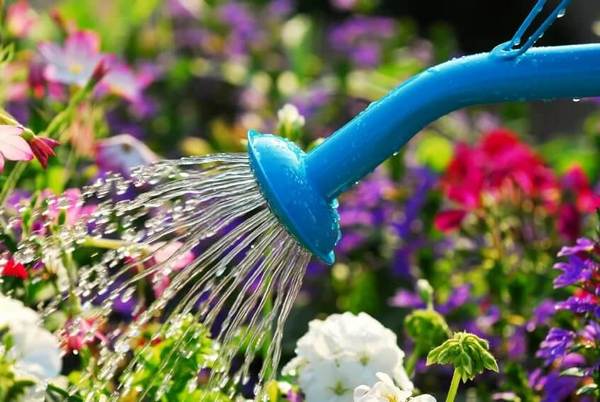

If there was not enough rain and snow, the plant will need additional watering.
On a note! If the soil is not fertile, organic fertilizers must be applied. This will allow you not to transplant the plant for a long time.
Muscari flower care
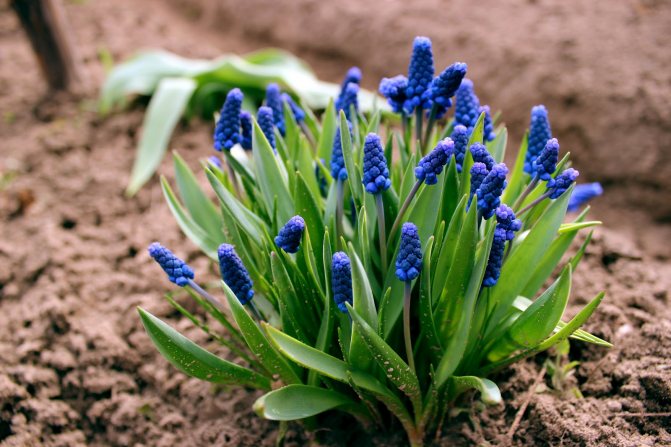

Even an inexperienced florist can handle the cultivation of muscari in a garden plot. It is important to set aside time for watering at the beginning of the growing season. However, spring usually brings rain and melt water, so you don't need to worry too much. In the event that the spring months are unusually dry, it is worth taking care of the plant.
Top dressing of muscari is carried out with solutions of organic fertilizers. This increases the fertility of the soil. At the end of the season, the perennial growing area is fertilized with humus or compost. If you observe the introduction of regular and full dressing and from time to time dig up the soil, then muscari will feel great in one place much longer than ordinary perennials.
Bloom
The flowering period usually lasts up to three weeks. At this time, caring for the flower includes regular loosening after watering.Withered flowers should be cut off and the color of the inflorescence should be monitored. Its changes may indicate unfavorable conditions for the plant. For example, that they need to be seated.


There are inflorescences changed color, maybe the plant is uncomfortable
What to do at the end of flowering?
| Sequencing | Description |
| The end of flowering indicates the onset of a dormant period. During this period, all peduncles are removed. Watering is done less and less and stops after the leaves on the bushes have completely dried. |
| After flowering, fertilizing is applied to the soil: a composition containing minerals, phosphorus and potassium for the bulbs. |
| In the fall, the site is dug up. If the plants have reached the age of five, they must be planted and sprinkled with peat. Bushes that have not been transplanted must be freed from dried leaves. |
This completes the preparation for winter, because the plant is frost-resistant.
On a note! There is no need to cover the onions.
Muscari after flowering
After the end of the flowering muscari, a number of specific actions are required to take care of the plant. It is necessary to carefully cut off the peduncles, then fertilize the soil with liquid fertilizer of a potassium-phosphorus composition. This will help the bulbs to better adapt to wintering. It is also good to get them out of the ground, dry them and dig them in again to prevent the possibility of deterioration.
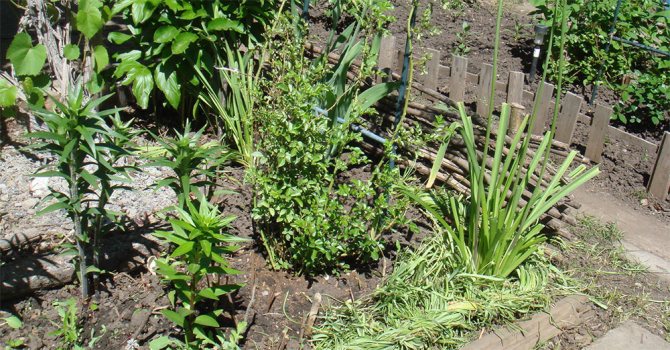

After the muscari have faded, they must be cut and fed.
After that, they begin to gradually reduce watering until the leaves turn yellow and wilt. When this happens, watering is completely stopped. Young flowers are covered with peat for the winter, after removing yellowed leaves on them. If the plants are in one place for a long time and there are signs of deterioration, they begin to transplant.
Preparing for winter
To prepare the plant for wintering, you need to add a sufficient amount of humus at the rate of 5 kg per one square meter; cut off the bunches that have completed flowering. Leaves are left until frost, this will help the bulbs gain strength. There is no special need to cover adult bulbs in winter, because the plant is frost-resistant.
How is the planting and care in the open field for the poultry farm. Dewdrop is one of the most popular carnivorous plants, learn more about it here.
Storing muscari bulbs
If there are special reasons for digging the bulbs out of the ground, then you need to know certain rules for storing them indoors:
- you need to start digging out the bulbs only after the leaves have dried;
- the dug out bulbs are dried for several days, then placed in peat, which can be replaced with wet clean sand;
- once a week, you should inspect and touch the bulbs, while removing those on which there are traces of rot or damage, also if they have become soft;
- in the storage, it is necessary to maintain an air humidity of about 70% and a temperature of 17 degrees.
Transfer
Muscari can be propagated in two ways.
The first is the use of seeds. After ripening, the seeds are harvested. Germination capacity lasts up to twelve months. Sowing is carried out in the fall, and shoots will appear by the spring. But flowering will have to wait 3-4 years.
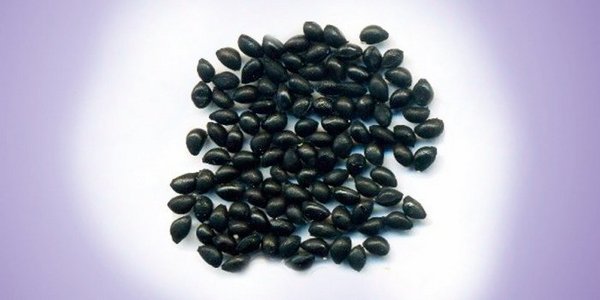

Muscari can be propagated by seeds
Reproduction in a vegetative way is carried out by planting young bulbs. A prerequisite is that a bush growing in the same place for 5-6 years can become a source for transplantation.
In September, an onion with "babies" is dug up, of which there are up to 30 pieces per copy. They are separated from the main bulb, dried in the sun and treated with preparations to stimulate the roots.
On a note! Next, they are planted according to the above scheme.
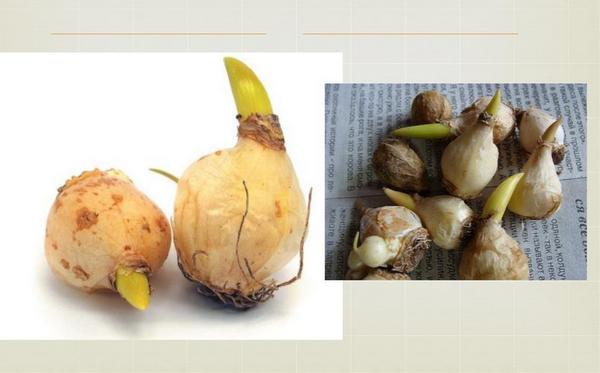

"Children" are separated from the bulb, and then planted
It should be mentioned that muscari can reproduce by self-seeding. To maintain the shape of the flower garden, you need to monitor the number of flowers.Excess peduncles can be removed after the flowering period.
Reproduction methods
Shrub Potentilla - what it looks like, types and varieties
In addition to the vegetative variant, this plant is capable of self-seeding propagation. For this reason, there is an uncontrolled proliferation of flowers throughout the area. To prevent this multiplication of flowers, you can remove the peduncles after flowering and leave a few for the seeds to ripen. Ripe seeds are harvested and sown in open ground to a depth of no more than 2 cm. As early as next spring, you can see thin seedlings, which indicate that the bulb has begun to form. Flowering from young plants can be expected no earlier than 2 years of age. It is easy to propagate bushes.
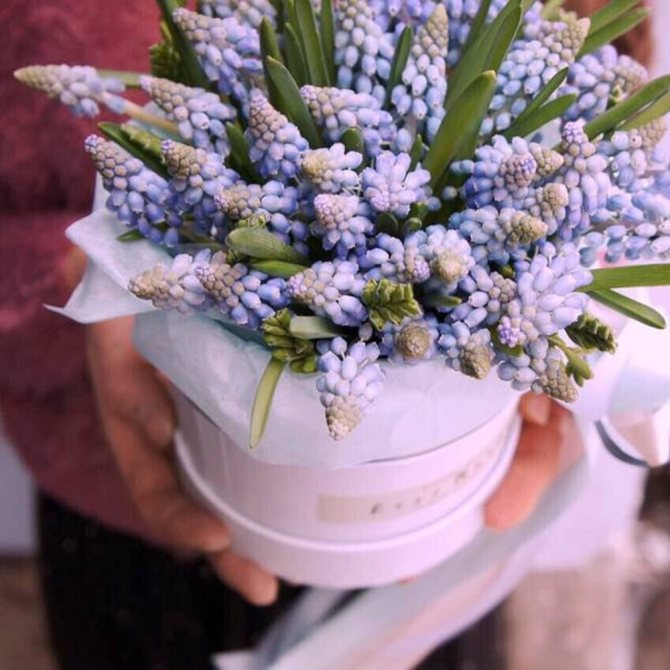

Pale blue muscari planted as a houseplant
Diseases and pests
Often the plant is affected by mosaic, the causative agent of which is the yellow dwarf onion virus. The disease changes the leaves - patchiness appears in the form of a mosaic, they narrow. The peduncle is deformed, the growth of the plant is hampered.
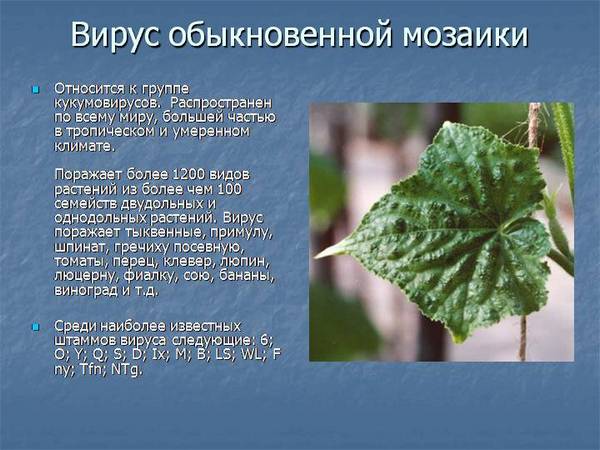

Mosaic
Cucumber mosaic leaves white streaks and spots on the leaves. In this case, the leaves are subject to deformation.
The spread of the virus is aphid, which can parasitize in the bulb. Therefore, the first step, having found signs of infection, it is necessary to dig up and destroy the bulbous material. In the future, it is necessary to carry out the destruction of aphids. To do this, it is effective to use a soap solution: two tablespoons of soap for half a liter of warm water.
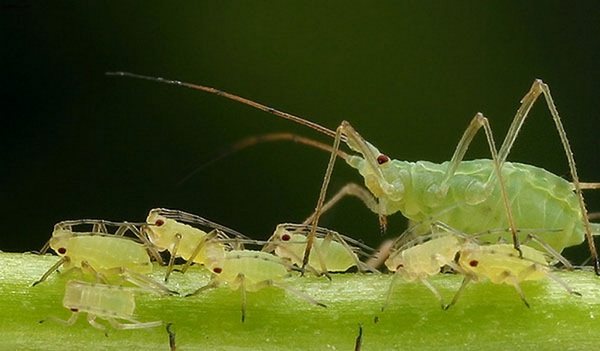

Spreads the aphid virus
On a note! If there are signs of spider mites parasitizing, it is necessary to treat with the drug "Aktofit". The spraying process is carried out strictly in accordance with the instructions for the preparation.
Watering and loosening the soil
Hydrangea Candelite - description and cultivation of the variety in the open field
The soil in the area of planting flowers should be constantly slightly damp. However, at the same time, stagnation of the liquid should not be allowed in order to prevent rotting of the root system. Irrigation is usually carried out in the morning.
After watering, it is recommended to weed the weed and loosen the soil. Timely removal of weeds allows you to achieve the most abundant flowering, because plants will be able to fully receive useful substances from the soil.
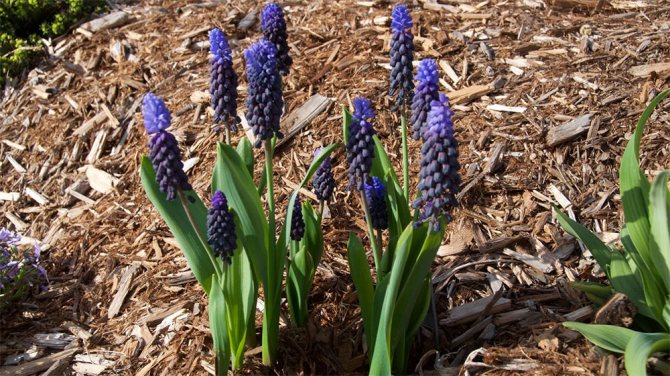

Mouse hyacinth during flowering
Storing the bulbs
To renew the sowing material, it is enough to dig out the bulbs once every four years. This is done in the fall. To prevent the bulbs from rotting, they must be thoroughly dried and buried again.
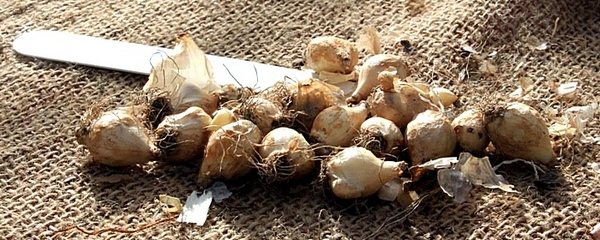

You can dig up bulbs for the winter
To preserve the bulbs until spring, you can dig them in, or you can keep them at home, providing special conditions. After drying, the bulbs are placed in moistened sand or peat.
On a note! Defective specimens are discarded once a week. In the storage room, the humidity should be 70 percent, and the air temperature should be 17-18 degrees Celsius.
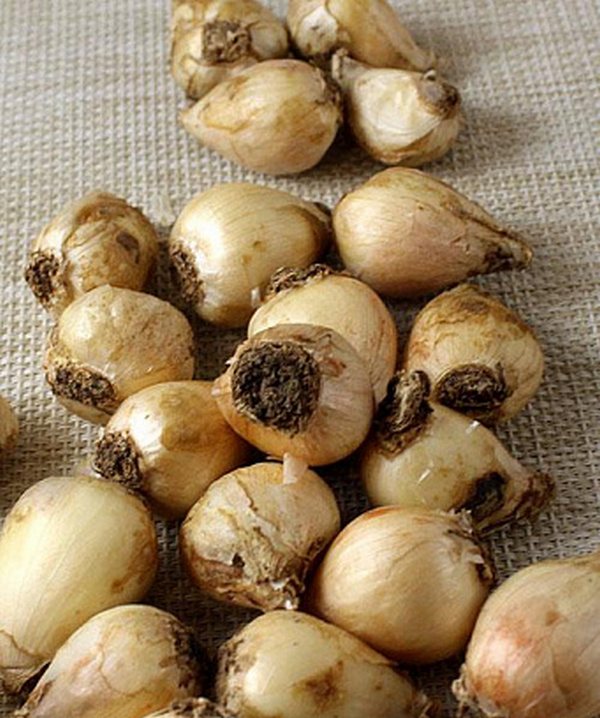

You need to store the bulbs in a room where the temperature will be at the level of 17-18 degrees Celsius
How muscari flowers winter
The described plant has a clear life cycle with a period of rest and activity. Some time after the wilting of the peduncle, the muscari begin to prepare for rest. The ground part, in contrast to the Pushkinia, does not dry out, but remains green until the winter cold. In regions with harsh winters, muscari planting needs to be covered with non-woven material or spruce branches.
Mouse hyacinth is cultivated for decorative purposes. They are used to decorate mixborders, lawns and flower beds. The abundantly flowering muscari bushes cannot be ignored in spring, when other plants are just beginning to wake up from hibernation. On the flower garden, muscari coexist perfectly with tulips, daffodils, hyacinths, crocuses, Pushkinia, forest trees, etc.
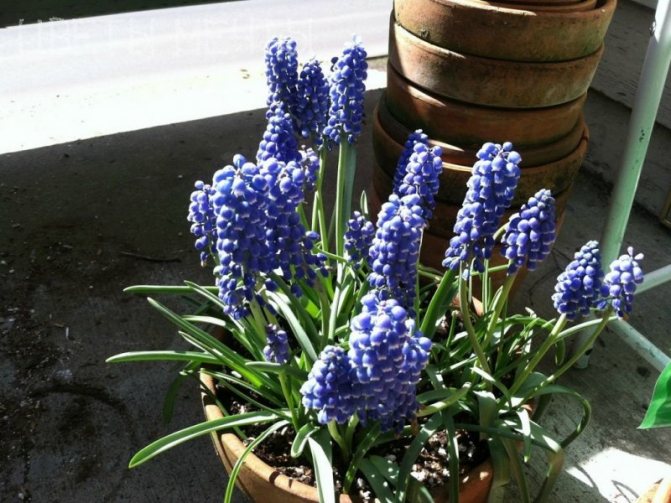

Output
Muscari has a beneficial effect on the flower neighborhood. The plant fertilizes the soil, scares away the smell of flies, mosquitoes.Cut flowers retain the same properties. In the place where the muscari is grown, you can plant other flowers, for example, roses, dahlias, daffodils.
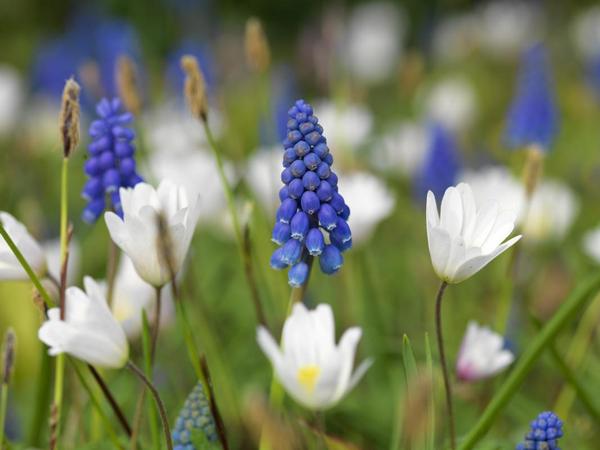

Muscari is a good neighbor for other flowers
By choosing the right color scheme for muscari and neighboring plants, you can create a beautiful composition in a flower bed.
How to plant muscari correctly
To achieve a decorative effect, muscari are planted in groups. The bulbs are placed side by side in 15 pieces, leaving free space for the future growth of each individual. Muscari look spectacular next to different colors of buds: blue, white, pink.
Before planting, the bulbs are inspected for damage and rot. The rejected material is thrown away, and the suitable material is processed in "Karbaphos" and then for another 30 minutes in a medium strength manganese solution.
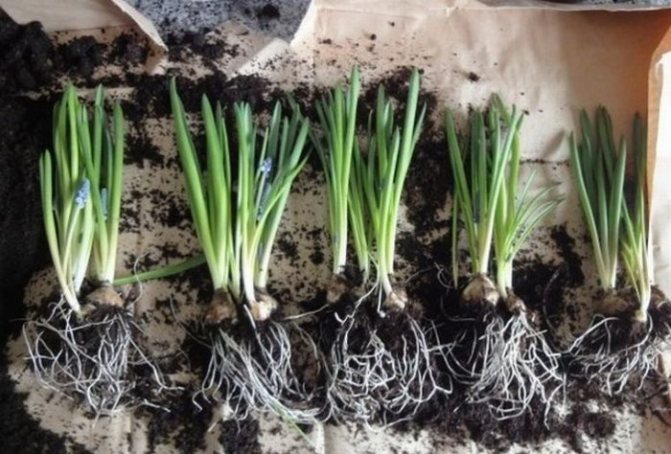

A place on the site for muscari is selected in partial shade or sunny. The main thing is that the site does not suffer from moisture stagnation.
Worth reading >>
• Everything about Cooper's variegated hibiscus


The soil is dug up, holes are formed, sand is laid out on their bottom. The bulbs are placed vertically, slightly pressing into the sand. The holes are covered with soil from above, lightly tamped and watered.
They do not need annual removal from the soil, no need to dig out muscari
, only for 4-5 years of planting thicken and need to be thinned. At this point, it is recommended to transplant the flower to a new location and propagate the primrose.
Questions From Readers
How long can a flower live in a garden?
It depends on the type of plant. Usually the duration is five to ten years. You can increase this period by correctly replanting the plant.
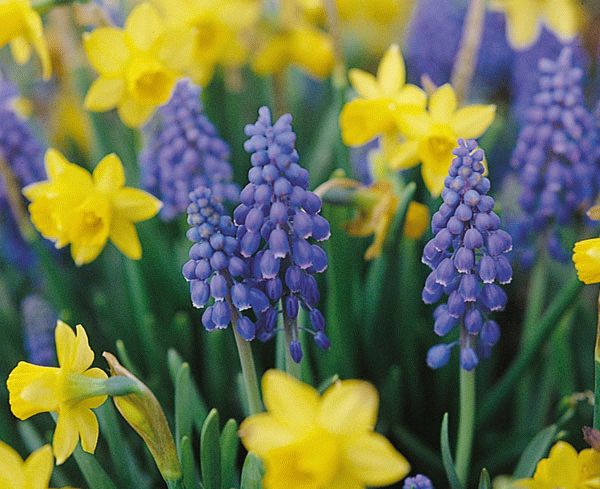

Muscari usually live for 5 to 10 years
For what reason does the plant not bloom?
There may be several reasons. If the flower is grown from seed, it will only bloom after 3-4 years. When propagated by a bulb, the absence of flowers can be explained by its mechanical damage: during loosening or by mice.
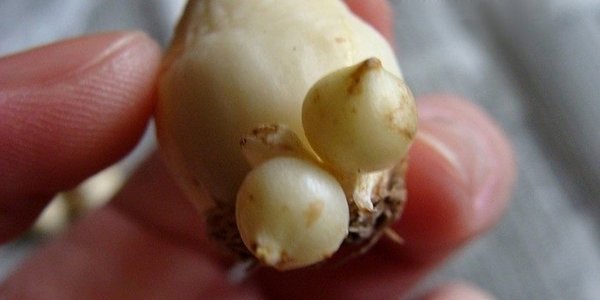

If the bulb has been damaged, the plant may not bloom.
What should be the care of a flower in the winter?
On the territory of Russia, mainly frost-resistant varieties are grown. Therefore, no special events are held. In the fall, dried leaves are cut off, plants are transplanted or planted. Young or sprouted flowers can be covered with spruce branches.
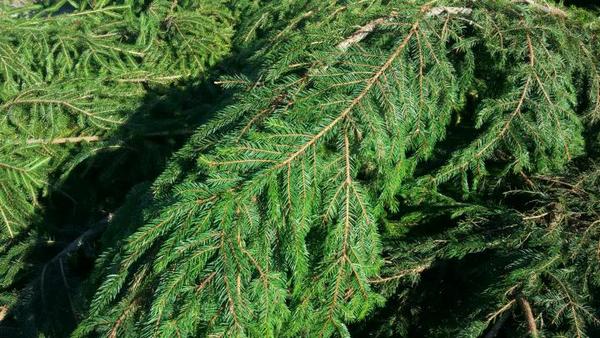

You can cover young flowers with spruce branches
Growing muscari is, in principle, not too difficult. It is important to observe all the conditions that are necessary for the normal growth and development of the plant, and you can enjoy the flowering of muscari.
Use in landscape design
Mouse hyacinths are actively used by landscape designers when landscaping a garden plot, lawn, rabatka, rock garden, garden paths. Low-growing ground cover grasses in combination with muscari will create a unique composition. Muscari also looks spectacular in a flower bed with growing nearby:
- tulips;
- hazel grouses;
- primrose;
- narcissists;
- crocuses.
Note! If you wish, you can plant hyacinths in pots and grow them on the balcony, creating a cozy place to relax there.
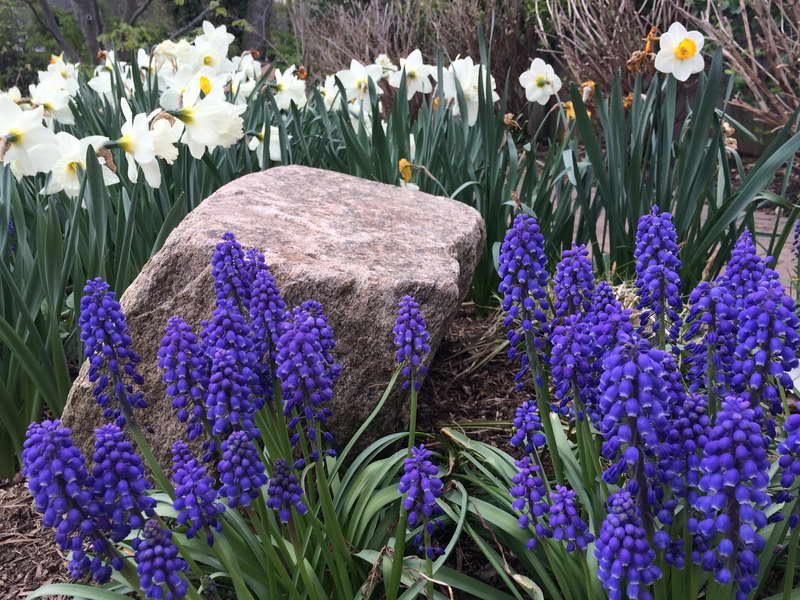

Muscari in landscape design
Muscari - flowers that can become a real highlight of the site. Flowers are often cut from the flower bed and create unique compositions or bouquets. The inflorescences can only be cut off when the lower flowers have begun to open. Compliance with the recommendations of specialists listed in the article regarding care will help to grow healthy bushes, pleasing with bright and abundant flowering.
Breeding muscari
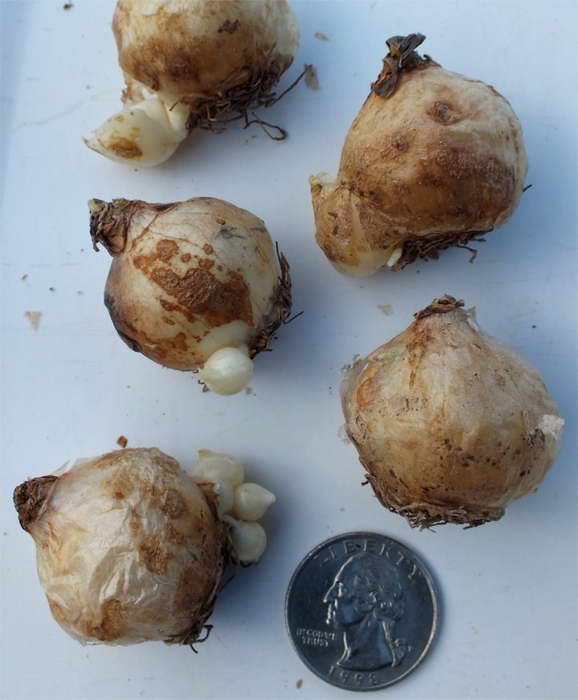

How muscari reproduces photo bulbs with babies
Most often, muscari are propagated vegetatively by daughter bulbs. One mother forms a nest of 30 bulbs over several years of growth. We dig it out and plant it from mid to late October. The landing method is described in detail above.
Muscari gives abundant self-seeding, which is why after flowering it is recommended to cut off wilted peduncles.If you do not control this process, the plantings will be dense, lose their decorative effect, and become like a weed.
Plants grown from seeds are more resistant to diseases and pests. To renew the muscari, leave a few stems to collect the seeds. They remain viable for no more than 12 months, it is better to sow immediately before winter. Dig up the area with humus, level it, sprinkle the seeds, cover it with a rake, cover with a layer of mulch. In the spring, seedlings will appear that look like green strings, thin out when they grow up. The first flowering will come in 2-3 years.
Description and features
In its natural environment, the plant is found in forests and on the mountain slopes of the Crimean Peninsula, the Caucasus, Mediterranean countries, Asia, Africa and Europe. Muscari belongs to the bulbous plants of the asparagus family. Previously, the flower was ranked among the varieties of hyacinths.
Muscari characteristics and features:
- The maximum flower height is 30-35cm.
- Leaves are narrow, long, green in color, re-grow in autumn.
- The flower stalk is tall, in the form of a bunch of grapes, with many small bell flowers of purple, blue, white and blue shades.
- The flower is resistant to sudden changes in temperature and frost.
- After the spring flowering period, the plant withers completely.
- Due to the early flowering, the plant is rarely exposed to diseases and pests.
Important! For the bulbs and flowers of Muscari, birds are not dangerous, because the plant contains substances that are poisonous for birds.
Home care
An unpretentious, charming flower will perfectly fit into any interior, bring special spring freshness and comfort to a city apartment, an open balcony or terrace. Growing mouse hyacinth in a separate flower container is easy. For these purposes, a container with a large number of holes at the bottom is chosen to remove excess water and eliminate liquid stagnation. Drainage material - expanded clay, broken brick or crushed walnut shells - is placed first in the flower container. Further, loose, fertilized, permeable soil is poured. Bulbs are planted in moist soil.
One of the features of growing muscari at home is the short growing season. The plant is kept indoors only during flowering. After the flowers wither and the leaves dry, the pot is transferred to the garden and partially buried. This procedure will allow the plant to form bulbs. The muscari flower pot stays in the garden until the end of winter.
With the beginning of spring, the pot is returned to the room, the bulbs are transplanted together with the earth into a new flower container, or the pot is placed in a beautiful planter.
Even in spite of the unpretentious nature of the plant, keeping it at home requires much more attention and energy than its counterparts growing in the open field.
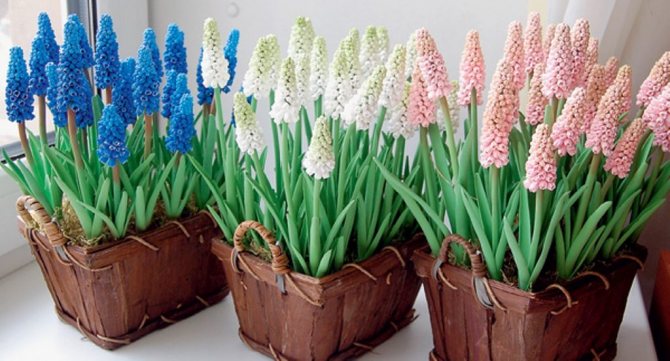

Watering
Muscari can be called a flower for busy people. Those who love beauty around them, but are not able to pay due attention to it. The flower endures flaws in content. The only time a plant needs care is during the flowering period. The hyacinth needs strength to open the flower. During this period, the soil around the muscari should be kept moist. Pouring water over the planting site of a flower is extremely dangerous, it is very susceptible to excess and stagnation of water.
Prolonged exposure to wet soil can cause rotting of the bulbs.
After 1.5-2 weeks, after the beginning of flowering, you can weaken your attention to watering the flower. Moreover, after flowering, the hyacinth goes into "dormant mode" and there is enough natural precipitation for the comfortable growth of the plant.
Thinning
Once planting a mouse hyacinth in the garden, after 3-4 years you can find a rather densely overgrown area. Muscari are thinned out as needed, when the flower has grown and in case of transplantation to a new place.To exclude self-seeding, after flowering, the arrow with the seeds is cut off.
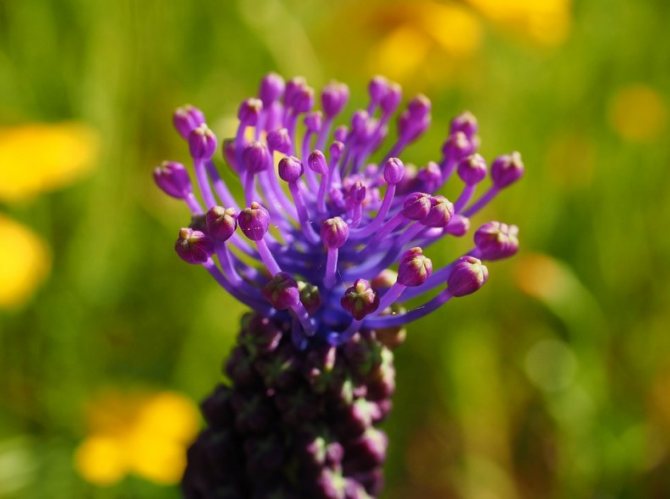

Fertilization and feeding
To maintain active growth, bright and lush flowering, the plant needs additional feeding. In the spring, when digging, organic fertilizers are applied to the soil at the rate of 4–5 kg of raw materials per square meter.
To provide the flower with all nutrients, compost is added to the soil in the fall. This will allow the bulbs to gain strength, survive the winter and wake up in the spring.
In a potted culture, muscari needs fertilizing twice a month during the growing season. Use a liquid special combined fertilizer for home ornamental plants.
Hyacinth is a long-liver, in one place it can grow quietly for 8-10 years.
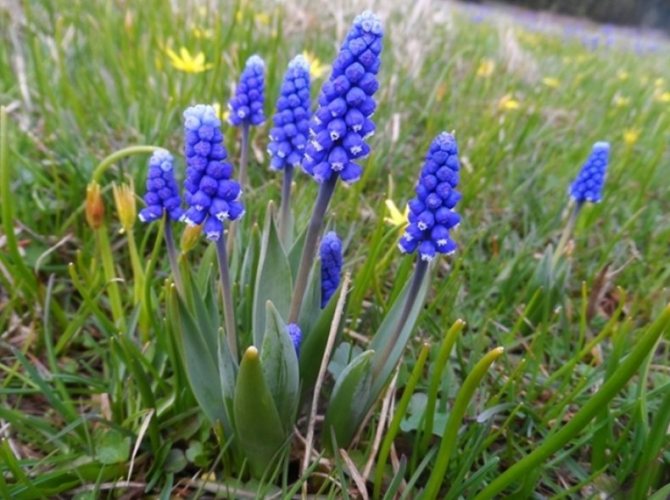

How to care for muscari in the garden
Mouse hyacinth is one of the first garden plants that pleases with its flowering, long before the rest of the plantings bloom. Nature has decreed that gentle, bright muscari panicles are not lost in the middle of the site. And all because nothing prevents the plant from reaching for the sun - the grass has not yet grown, the leaves on the trees have not blossomed.
The flower will put up with any place in the garden, be it a bright, open meadow or at the foot of trees in partial shade. The main thing is that the hyacinth is not planted in the lowlands and low areas of the garden. Prolonged stagnation of water is destructive for a flower. To leave completely undemanding. Bulbs in the ground calmly endure winters in central Russia.
Proper care and maintenance will allow muscari to form larger and healthier bulbs, flowering will be brighter, more intense and lasting.
General care rules are suitable for all types of mouse hyacinth, however, some varieties require more careful attention from the grower. So, the broadleaf species and Osh need soil mulching.
Periodically, the soil around the bulb is checked for weeds. Unwanted vegetation, dried leaves are removed, the soil is loosened. Moreover, the leaves from the plant are removed after their complete withering away. During the period of active growth, the plant cannot be completely cut off. As a result of such actions, bulbs suffer, which react sharply to a sharp interruption in the growth process. If you often cut off the aerial part, then the bulbs are gradually crushed and after a while they will simply disappear.
Soil requirements
An amazing perennial is very tenacious, able to take root on the ground with any mechanical composition. If you set yourself a goal, provide the flower with ideal growth conditions, then first of all, loose, fertile soil is selected. The earthen substrate must pass water well, the stagnation of the liquid is detrimental to the plant.
Muscari after flowering
If the plant was not grown for cutting, then after flowering, the stems should be cut off. Moreover, it is better to carry out the procedure for removing the inflorescence until the seeds are fully ripe. Ripening fruits take a lot of energy from the bulb. Many gardeners do not remove the inflorescences, allowing the fruit to ripen. Thus, allowing the plant to reproduce by seed.
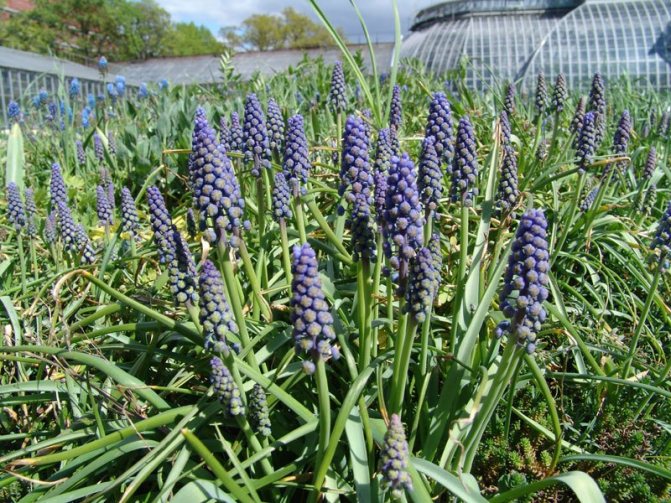

Preparing for winter
One of the advantages of muscari is its resistance to the cold season. Dry soil, dead leaves will serve as a good shelter for the bulb for the winter. Additional shelter is required only for some species and varieties.

